Police Intelligence & Technology
VerifiedAdded on 2020/05/16
|20
|4674
|413
AI Summary
This assignment delves into the evolving landscape of police intelligence, emphasizing the influence of technology. It analyzes various technological tools used in crime analysis, investigation, and proactive policing strategies. The discussion encompasses topics like open-source intelligence, social media analysis, crime mapping, and data protection policies within the context of modern law enforcement.
Contribute Materials
Your contribution can guide someone’s learning journey. Share your
documents today.
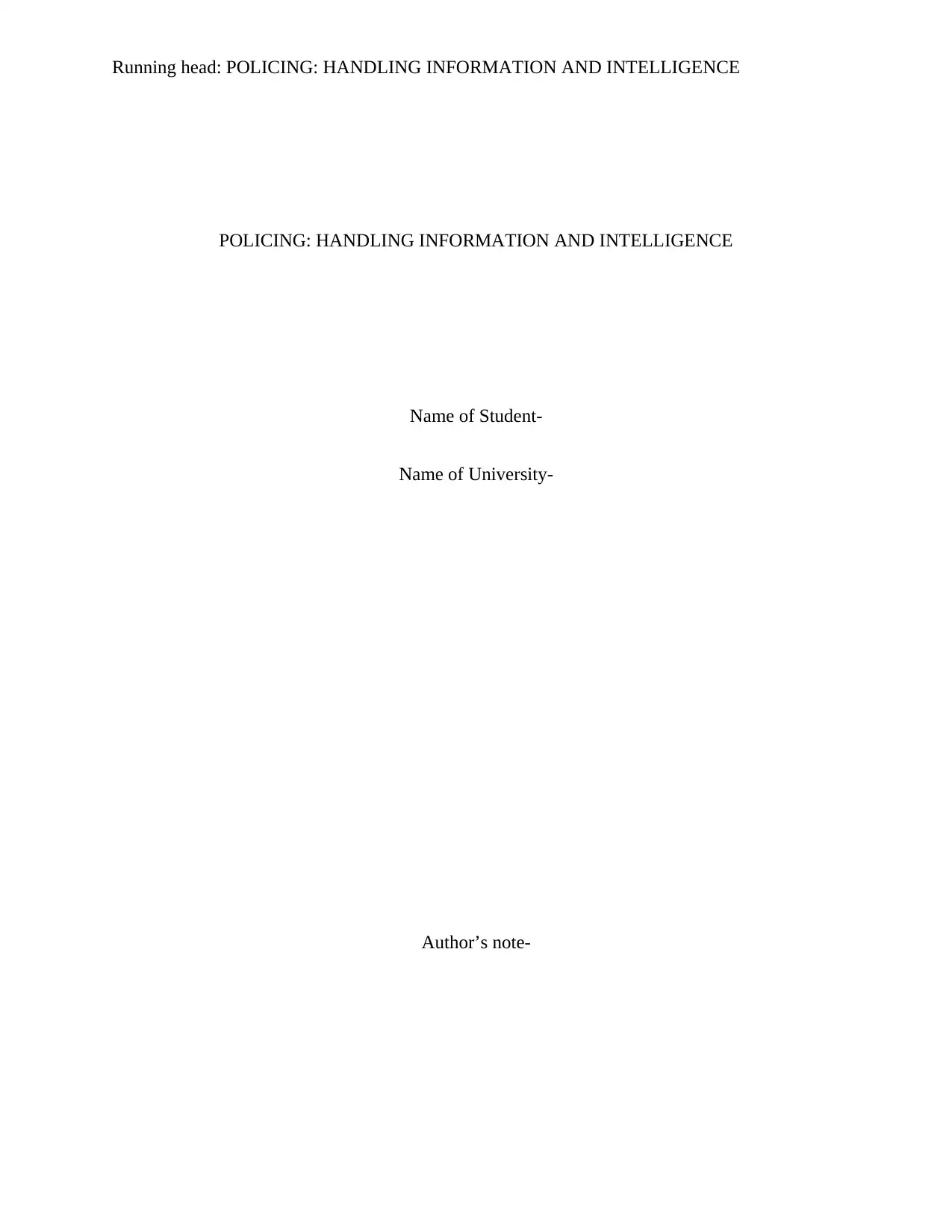
Running head: POLICING: HANDLING INFORMATION AND INTELLIGENCE
POLICING: HANDLING INFORMATION AND INTELLIGENCE
Name of Student-
Name of University-
Author’s note-
POLICING: HANDLING INFORMATION AND INTELLIGENCE
Name of Student-
Name of University-
Author’s note-
Secure Best Marks with AI Grader
Need help grading? Try our AI Grader for instant feedback on your assignments.
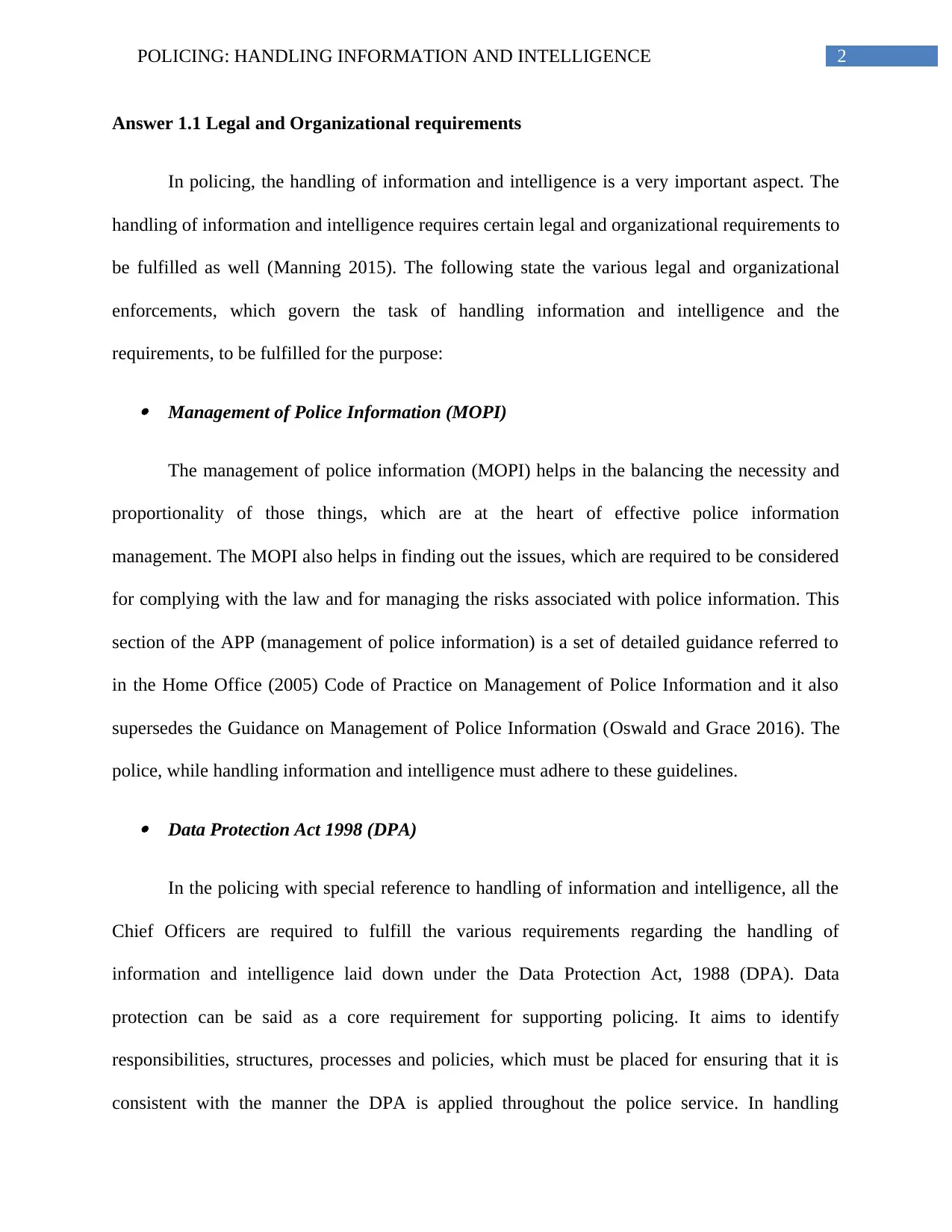
2POLICING: HANDLING INFORMATION AND INTELLIGENCE
Answer 1.1 Legal and Organizational requirements
In policing, the handling of information and intelligence is a very important aspect. The
handling of information and intelligence requires certain legal and organizational requirements to
be fulfilled as well (Manning 2015). The following state the various legal and organizational
enforcements, which govern the task of handling information and intelligence and the
requirements, to be fulfilled for the purpose:
Management of Police Information (MOPI)
The management of police information (MOPI) helps in the balancing the necessity and
proportionality of those things, which are at the heart of effective police information
management. The MOPI also helps in finding out the issues, which are required to be considered
for complying with the law and for managing the risks associated with police information. This
section of the APP (management of police information) is a set of detailed guidance referred to
in the Home Office (2005) Code of Practice on Management of Police Information and it also
supersedes the Guidance on Management of Police Information (Oswald and Grace 2016). The
police, while handling information and intelligence must adhere to these guidelines.
Data Protection Act 1998 (DPA)
In the policing with special reference to handling of information and intelligence, all the
Chief Officers are required to fulfill the various requirements regarding the handling of
information and intelligence laid down under the Data Protection Act, 1988 (DPA). Data
protection can be said as a core requirement for supporting policing. It aims to identify
responsibilities, structures, processes and policies, which must be placed for ensuring that it is
consistent with the manner the DPA is applied throughout the police service. In handling
Answer 1.1 Legal and Organizational requirements
In policing, the handling of information and intelligence is a very important aspect. The
handling of information and intelligence requires certain legal and organizational requirements to
be fulfilled as well (Manning 2015). The following state the various legal and organizational
enforcements, which govern the task of handling information and intelligence and the
requirements, to be fulfilled for the purpose:
Management of Police Information (MOPI)
The management of police information (MOPI) helps in the balancing the necessity and
proportionality of those things, which are at the heart of effective police information
management. The MOPI also helps in finding out the issues, which are required to be considered
for complying with the law and for managing the risks associated with police information. This
section of the APP (management of police information) is a set of detailed guidance referred to
in the Home Office (2005) Code of Practice on Management of Police Information and it also
supersedes the Guidance on Management of Police Information (Oswald and Grace 2016). The
police, while handling information and intelligence must adhere to these guidelines.
Data Protection Act 1998 (DPA)
In the policing with special reference to handling of information and intelligence, all the
Chief Officers are required to fulfill the various requirements regarding the handling of
information and intelligence laid down under the Data Protection Act, 1988 (DPA). Data
protection can be said as a core requirement for supporting policing. It aims to identify
responsibilities, structures, processes and policies, which must be placed for ensuring that it is
consistent with the manner the DPA is applied throughout the police service. In handling
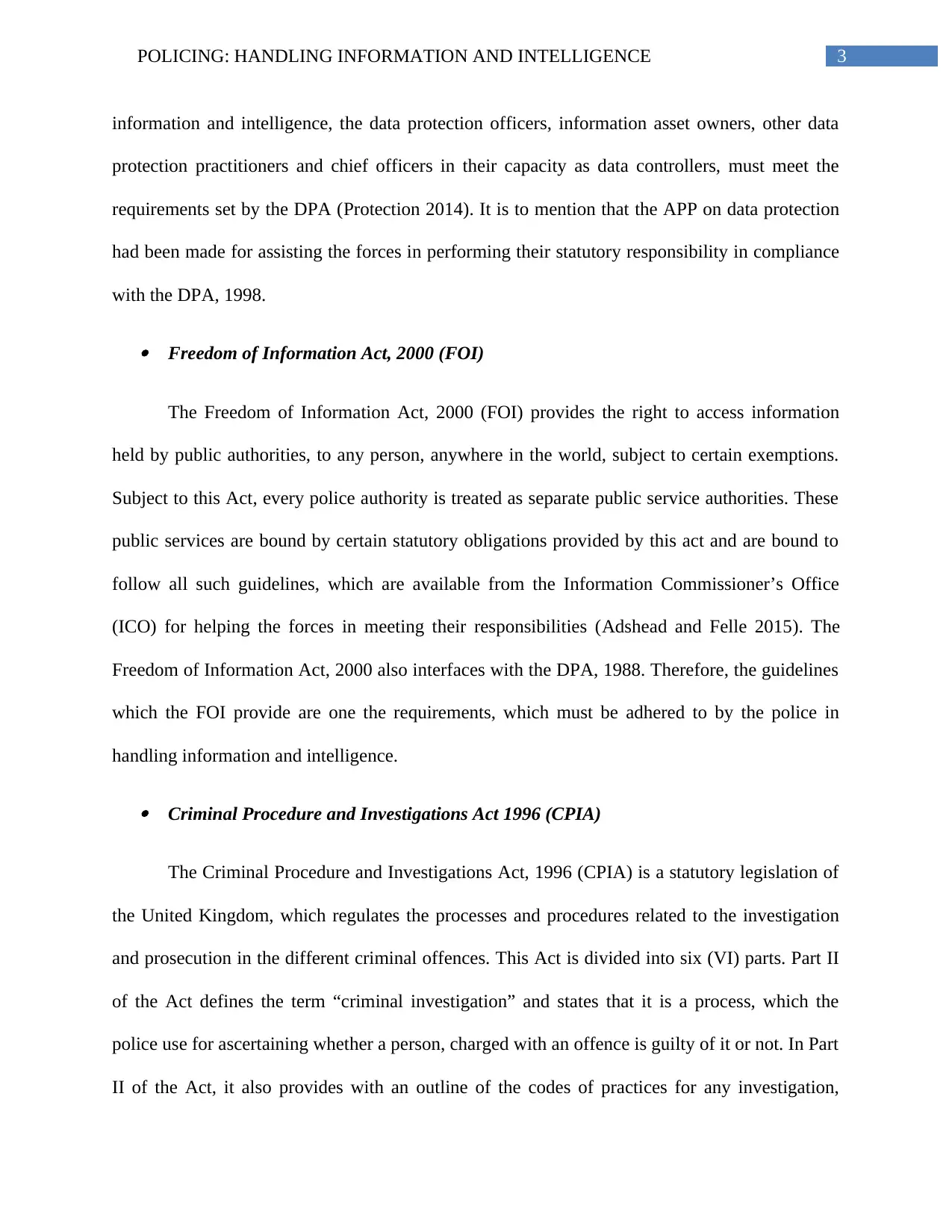
3POLICING: HANDLING INFORMATION AND INTELLIGENCE
information and intelligence, the data protection officers, information asset owners, other data
protection practitioners and chief officers in their capacity as data controllers, must meet the
requirements set by the DPA (Protection 2014). It is to mention that the APP on data protection
had been made for assisting the forces in performing their statutory responsibility in compliance
with the DPA, 1998.
Freedom of Information Act, 2000 (FOI)
The Freedom of Information Act, 2000 (FOI) provides the right to access information
held by public authorities, to any person, anywhere in the world, subject to certain exemptions.
Subject to this Act, every police authority is treated as separate public service authorities. These
public services are bound by certain statutory obligations provided by this act and are bound to
follow all such guidelines, which are available from the Information Commissioner’s Office
(ICO) for helping the forces in meeting their responsibilities (Adshead and Felle 2015). The
Freedom of Information Act, 2000 also interfaces with the DPA, 1988. Therefore, the guidelines
which the FOI provide are one the requirements, which must be adhered to by the police in
handling information and intelligence.
Criminal Procedure and Investigations Act 1996 (CPIA)
The Criminal Procedure and Investigations Act, 1996 (CPIA) is a statutory legislation of
the United Kingdom, which regulates the processes and procedures related to the investigation
and prosecution in the different criminal offences. This Act is divided into six (VI) parts. Part II
of the Act defines the term “criminal investigation” and states that it is a process, which the
police use for ascertaining whether a person, charged with an offence is guilty of it or not. In Part
II of the Act, it also provides with an outline of the codes of practices for any investigation,
information and intelligence, the data protection officers, information asset owners, other data
protection practitioners and chief officers in their capacity as data controllers, must meet the
requirements set by the DPA (Protection 2014). It is to mention that the APP on data protection
had been made for assisting the forces in performing their statutory responsibility in compliance
with the DPA, 1998.
Freedom of Information Act, 2000 (FOI)
The Freedom of Information Act, 2000 (FOI) provides the right to access information
held by public authorities, to any person, anywhere in the world, subject to certain exemptions.
Subject to this Act, every police authority is treated as separate public service authorities. These
public services are bound by certain statutory obligations provided by this act and are bound to
follow all such guidelines, which are available from the Information Commissioner’s Office
(ICO) for helping the forces in meeting their responsibilities (Adshead and Felle 2015). The
Freedom of Information Act, 2000 also interfaces with the DPA, 1988. Therefore, the guidelines
which the FOI provide are one the requirements, which must be adhered to by the police in
handling information and intelligence.
Criminal Procedure and Investigations Act 1996 (CPIA)
The Criminal Procedure and Investigations Act, 1996 (CPIA) is a statutory legislation of
the United Kingdom, which regulates the processes and procedures related to the investigation
and prosecution in the different criminal offences. This Act is divided into six (VI) parts. Part II
of the Act defines the term “criminal investigation” and states that it is a process, which the
police use for ascertaining whether a person, charged with an offence is guilty of it or not. In Part
II of the Act, it also provides with an outline of the codes of practices for any investigation,
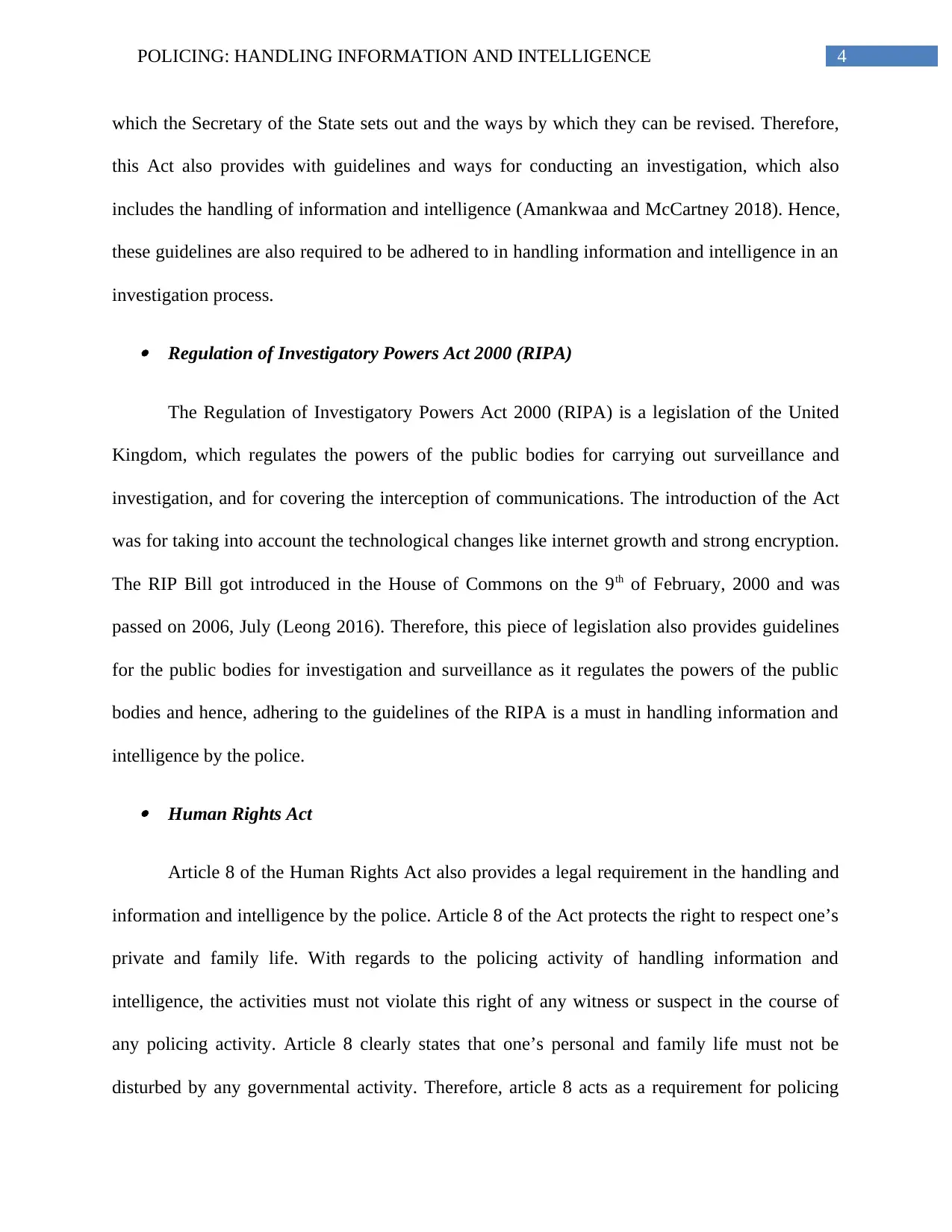
4POLICING: HANDLING INFORMATION AND INTELLIGENCE
which the Secretary of the State sets out and the ways by which they can be revised. Therefore,
this Act also provides with guidelines and ways for conducting an investigation, which also
includes the handling of information and intelligence (Amankwaa and McCartney 2018). Hence,
these guidelines are also required to be adhered to in handling information and intelligence in an
investigation process.
Regulation of Investigatory Powers Act 2000 (RIPA)
The Regulation of Investigatory Powers Act 2000 (RIPA) is a legislation of the United
Kingdom, which regulates the powers of the public bodies for carrying out surveillance and
investigation, and for covering the interception of communications. The introduction of the Act
was for taking into account the technological changes like internet growth and strong encryption.
The RIP Bill got introduced in the House of Commons on the 9th of February, 2000 and was
passed on 2006, July (Leong 2016). Therefore, this piece of legislation also provides guidelines
for the public bodies for investigation and surveillance as it regulates the powers of the public
bodies and hence, adhering to the guidelines of the RIPA is a must in handling information and
intelligence by the police.
Human Rights Act
Article 8 of the Human Rights Act also provides a legal requirement in the handling and
information and intelligence by the police. Article 8 of the Act protects the right to respect one’s
private and family life. With regards to the policing activity of handling information and
intelligence, the activities must not violate this right of any witness or suspect in the course of
any policing activity. Article 8 clearly states that one’s personal and family life must not be
disturbed by any governmental activity. Therefore, article 8 acts as a requirement for policing
which the Secretary of the State sets out and the ways by which they can be revised. Therefore,
this Act also provides with guidelines and ways for conducting an investigation, which also
includes the handling of information and intelligence (Amankwaa and McCartney 2018). Hence,
these guidelines are also required to be adhered to in handling information and intelligence in an
investigation process.
Regulation of Investigatory Powers Act 2000 (RIPA)
The Regulation of Investigatory Powers Act 2000 (RIPA) is a legislation of the United
Kingdom, which regulates the powers of the public bodies for carrying out surveillance and
investigation, and for covering the interception of communications. The introduction of the Act
was for taking into account the technological changes like internet growth and strong encryption.
The RIP Bill got introduced in the House of Commons on the 9th of February, 2000 and was
passed on 2006, July (Leong 2016). Therefore, this piece of legislation also provides guidelines
for the public bodies for investigation and surveillance as it regulates the powers of the public
bodies and hence, adhering to the guidelines of the RIPA is a must in handling information and
intelligence by the police.
Human Rights Act
Article 8 of the Human Rights Act also provides a legal requirement in the handling and
information and intelligence by the police. Article 8 of the Act protects the right to respect one’s
private and family life. With regards to the policing activity of handling information and
intelligence, the activities must not violate this right of any witness or suspect in the course of
any policing activity. Article 8 clearly states that one’s personal and family life must not be
disturbed by any governmental activity. Therefore, article 8 acts as a requirement for policing
Secure Best Marks with AI Grader
Need help grading? Try our AI Grader for instant feedback on your assignments.
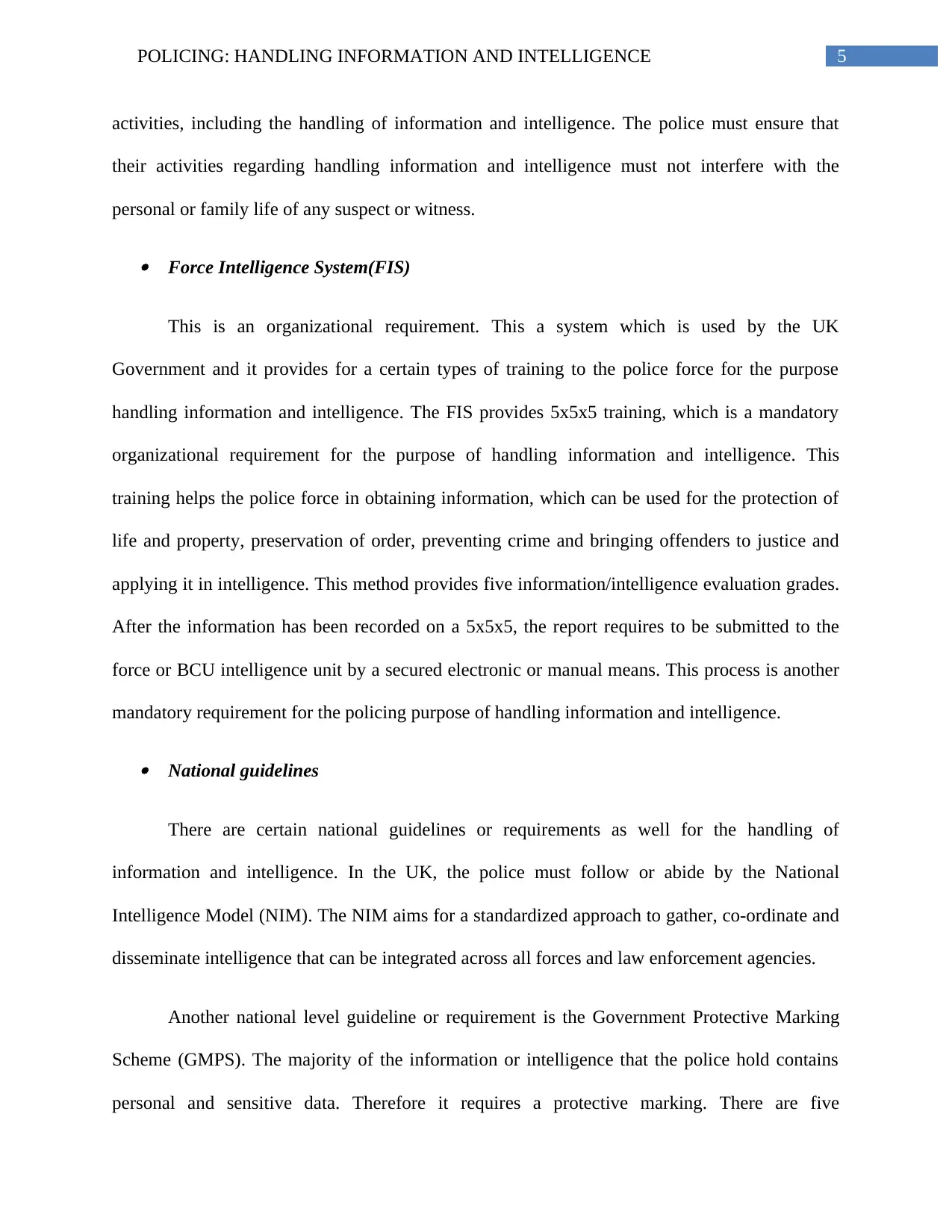
5POLICING: HANDLING INFORMATION AND INTELLIGENCE
activities, including the handling of information and intelligence. The police must ensure that
their activities regarding handling information and intelligence must not interfere with the
personal or family life of any suspect or witness.
Force Intelligence System(FIS)
This is an organizational requirement. This a system which is used by the UK
Government and it provides for a certain types of training to the police force for the purpose
handling information and intelligence. The FIS provides 5x5x5 training, which is a mandatory
organizational requirement for the purpose of handling information and intelligence. This
training helps the police force in obtaining information, which can be used for the protection of
life and property, preservation of order, preventing crime and bringing offenders to justice and
applying it in intelligence. This method provides five information/intelligence evaluation grades.
After the information has been recorded on a 5x5x5, the report requires to be submitted to the
force or BCU intelligence unit by a secured electronic or manual means. This process is another
mandatory requirement for the policing purpose of handling information and intelligence.
National guidelines
There are certain national guidelines or requirements as well for the handling of
information and intelligence. In the UK, the police must follow or abide by the National
Intelligence Model (NIM). The NIM aims for a standardized approach to gather, co-ordinate and
disseminate intelligence that can be integrated across all forces and law enforcement agencies.
Another national level guideline or requirement is the Government Protective Marking
Scheme (GMPS). The majority of the information or intelligence that the police hold contains
personal and sensitive data. Therefore it requires a protective marking. There are five
activities, including the handling of information and intelligence. The police must ensure that
their activities regarding handling information and intelligence must not interfere with the
personal or family life of any suspect or witness.
Force Intelligence System(FIS)
This is an organizational requirement. This a system which is used by the UK
Government and it provides for a certain types of training to the police force for the purpose
handling information and intelligence. The FIS provides 5x5x5 training, which is a mandatory
organizational requirement for the purpose of handling information and intelligence. This
training helps the police force in obtaining information, which can be used for the protection of
life and property, preservation of order, preventing crime and bringing offenders to justice and
applying it in intelligence. This method provides five information/intelligence evaluation grades.
After the information has been recorded on a 5x5x5, the report requires to be submitted to the
force or BCU intelligence unit by a secured electronic or manual means. This process is another
mandatory requirement for the policing purpose of handling information and intelligence.
National guidelines
There are certain national guidelines or requirements as well for the handling of
information and intelligence. In the UK, the police must follow or abide by the National
Intelligence Model (NIM). The NIM aims for a standardized approach to gather, co-ordinate and
disseminate intelligence that can be integrated across all forces and law enforcement agencies.
Another national level guideline or requirement is the Government Protective Marking
Scheme (GMPS). The majority of the information or intelligence that the police hold contains
personal and sensitive data. Therefore it requires a protective marking. There are five
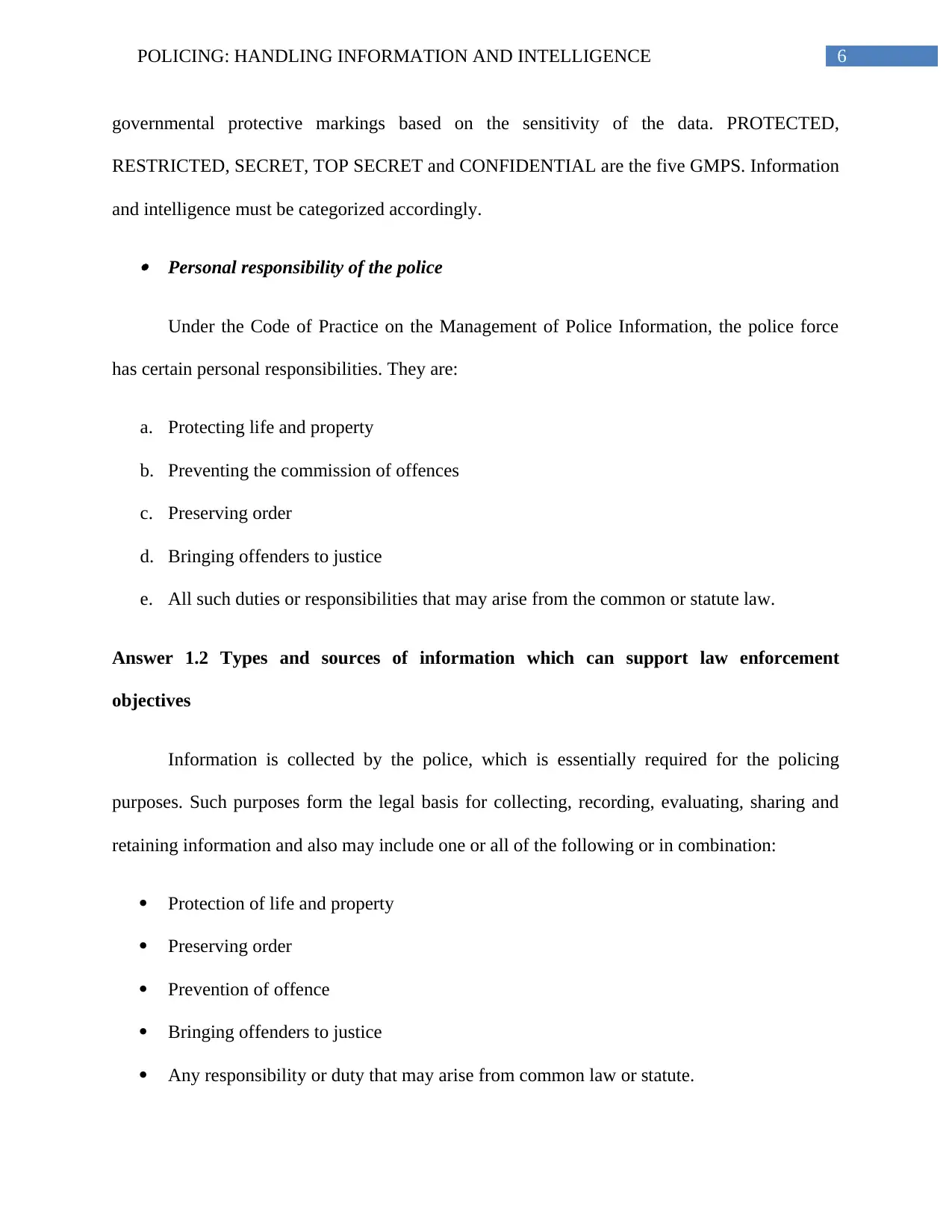
6POLICING: HANDLING INFORMATION AND INTELLIGENCE
governmental protective markings based on the sensitivity of the data. PROTECTED,
RESTRICTED, SECRET, TOP SECRET and CONFIDENTIAL are the five GMPS. Information
and intelligence must be categorized accordingly.
Personal responsibility of the police
Under the Code of Practice on the Management of Police Information, the police force
has certain personal responsibilities. They are:
a. Protecting life and property
b. Preventing the commission of offences
c. Preserving order
d. Bringing offenders to justice
e. All such duties or responsibilities that may arise from the common or statute law.
Answer 1.2 Types and sources of information which can support law enforcement
objectives
Information is collected by the police, which is essentially required for the policing
purposes. Such purposes form the legal basis for collecting, recording, evaluating, sharing and
retaining information and also may include one or all of the following or in combination:
Protection of life and property
Preserving order
Prevention of offence
Bringing offenders to justice
Any responsibility or duty that may arise from common law or statute.
governmental protective markings based on the sensitivity of the data. PROTECTED,
RESTRICTED, SECRET, TOP SECRET and CONFIDENTIAL are the five GMPS. Information
and intelligence must be categorized accordingly.
Personal responsibility of the police
Under the Code of Practice on the Management of Police Information, the police force
has certain personal responsibilities. They are:
a. Protecting life and property
b. Preventing the commission of offences
c. Preserving order
d. Bringing offenders to justice
e. All such duties or responsibilities that may arise from the common or statute law.
Answer 1.2 Types and sources of information which can support law enforcement
objectives
Information is collected by the police, which is essentially required for the policing
purposes. Such purposes form the legal basis for collecting, recording, evaluating, sharing and
retaining information and also may include one or all of the following or in combination:
Protection of life and property
Preserving order
Prevention of offence
Bringing offenders to justice
Any responsibility or duty that may arise from common law or statute.
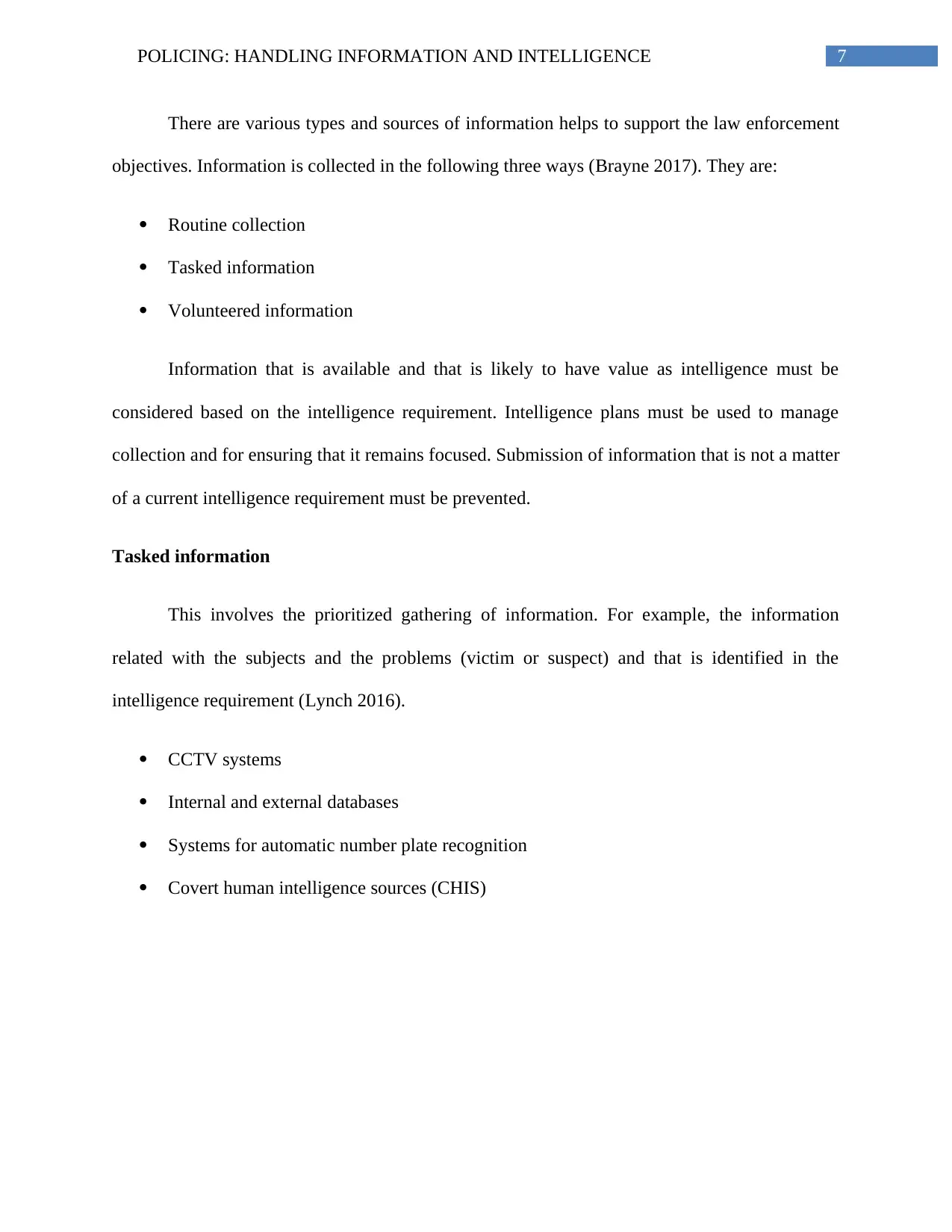
7POLICING: HANDLING INFORMATION AND INTELLIGENCE
There are various types and sources of information helps to support the law enforcement
objectives. Information is collected in the following three ways (Brayne 2017). They are:
Routine collection
Tasked information
Volunteered information
Information that is available and that is likely to have value as intelligence must be
considered based on the intelligence requirement. Intelligence plans must be used to manage
collection and for ensuring that it remains focused. Submission of information that is not a matter
of a current intelligence requirement must be prevented.
Tasked information
This involves the prioritized gathering of information. For example, the information
related with the subjects and the problems (victim or suspect) and that is identified in the
intelligence requirement (Lynch 2016).
CCTV systems
Internal and external databases
Systems for automatic number plate recognition
Covert human intelligence sources (CHIS)
There are various types and sources of information helps to support the law enforcement
objectives. Information is collected in the following three ways (Brayne 2017). They are:
Routine collection
Tasked information
Volunteered information
Information that is available and that is likely to have value as intelligence must be
considered based on the intelligence requirement. Intelligence plans must be used to manage
collection and for ensuring that it remains focused. Submission of information that is not a matter
of a current intelligence requirement must be prevented.
Tasked information
This involves the prioritized gathering of information. For example, the information
related with the subjects and the problems (victim or suspect) and that is identified in the
intelligence requirement (Lynch 2016).
CCTV systems
Internal and external databases
Systems for automatic number plate recognition
Covert human intelligence sources (CHIS)
Paraphrase This Document
Need a fresh take? Get an instant paraphrase of this document with our AI Paraphraser
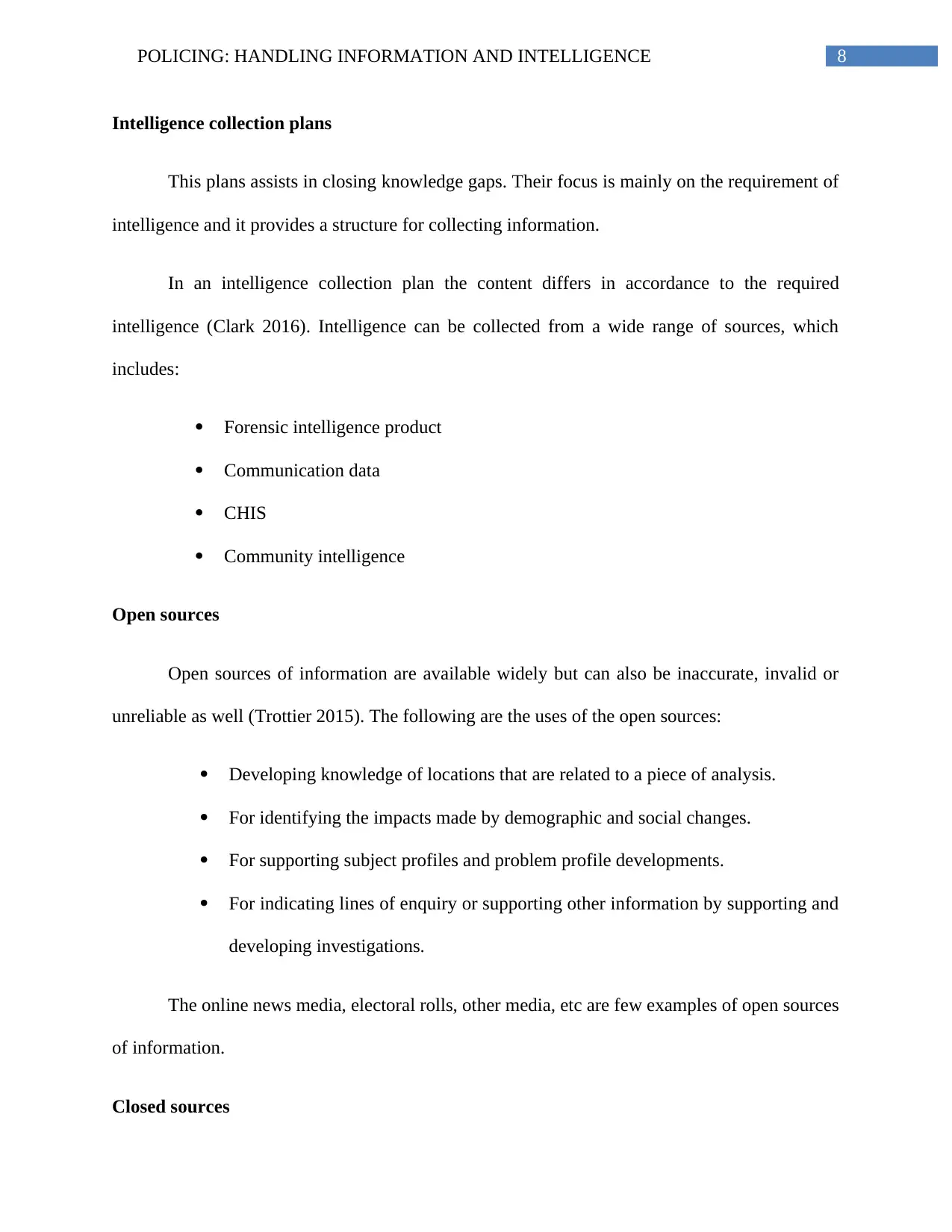
8POLICING: HANDLING INFORMATION AND INTELLIGENCE
Intelligence collection plans
This plans assists in closing knowledge gaps. Their focus is mainly on the requirement of
intelligence and it provides a structure for collecting information.
In an intelligence collection plan the content differs in accordance to the required
intelligence (Clark 2016). Intelligence can be collected from a wide range of sources, which
includes:
Forensic intelligence product
Communication data
CHIS
Community intelligence
Open sources
Open sources of information are available widely but can also be inaccurate, invalid or
unreliable as well (Trottier 2015). The following are the uses of the open sources:
Developing knowledge of locations that are related to a piece of analysis.
For identifying the impacts made by demographic and social changes.
For supporting subject profiles and problem profile developments.
For indicating lines of enquiry or supporting other information by supporting and
developing investigations.
The online news media, electoral rolls, other media, etc are few examples of open sources
of information.
Closed sources
Intelligence collection plans
This plans assists in closing knowledge gaps. Their focus is mainly on the requirement of
intelligence and it provides a structure for collecting information.
In an intelligence collection plan the content differs in accordance to the required
intelligence (Clark 2016). Intelligence can be collected from a wide range of sources, which
includes:
Forensic intelligence product
Communication data
CHIS
Community intelligence
Open sources
Open sources of information are available widely but can also be inaccurate, invalid or
unreliable as well (Trottier 2015). The following are the uses of the open sources:
Developing knowledge of locations that are related to a piece of analysis.
For identifying the impacts made by demographic and social changes.
For supporting subject profiles and problem profile developments.
For indicating lines of enquiry or supporting other information by supporting and
developing investigations.
The online news media, electoral rolls, other media, etc are few examples of open sources
of information.
Closed sources
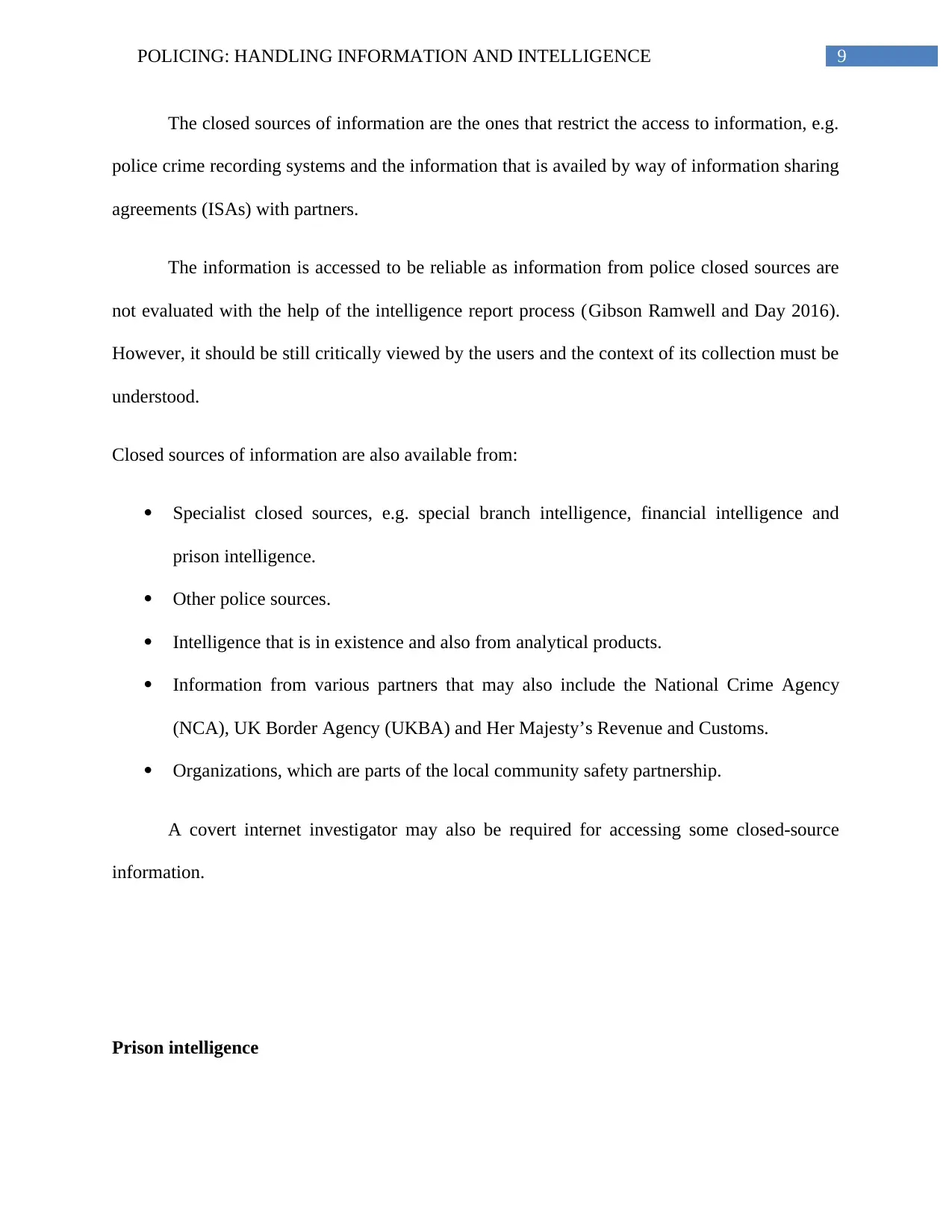
9POLICING: HANDLING INFORMATION AND INTELLIGENCE
The closed sources of information are the ones that restrict the access to information, e.g.
police crime recording systems and the information that is availed by way of information sharing
agreements (ISAs) with partners.
The information is accessed to be reliable as information from police closed sources are
not evaluated with the help of the intelligence report process (Gibson Ramwell and Day 2016).
However, it should be still critically viewed by the users and the context of its collection must be
understood.
Closed sources of information are also available from:
Specialist closed sources, e.g. special branch intelligence, financial intelligence and
prison intelligence.
Other police sources.
Intelligence that is in existence and also from analytical products.
Information from various partners that may also include the National Crime Agency
(NCA), UK Border Agency (UKBA) and Her Majesty’s Revenue and Customs.
Organizations, which are parts of the local community safety partnership.
A covert internet investigator may also be required for accessing some closed-source
information.
Prison intelligence
The closed sources of information are the ones that restrict the access to information, e.g.
police crime recording systems and the information that is availed by way of information sharing
agreements (ISAs) with partners.
The information is accessed to be reliable as information from police closed sources are
not evaluated with the help of the intelligence report process (Gibson Ramwell and Day 2016).
However, it should be still critically viewed by the users and the context of its collection must be
understood.
Closed sources of information are also available from:
Specialist closed sources, e.g. special branch intelligence, financial intelligence and
prison intelligence.
Other police sources.
Intelligence that is in existence and also from analytical products.
Information from various partners that may also include the National Crime Agency
(NCA), UK Border Agency (UKBA) and Her Majesty’s Revenue and Customs.
Organizations, which are parts of the local community safety partnership.
A covert internet investigator may also be required for accessing some closed-source
information.
Prison intelligence
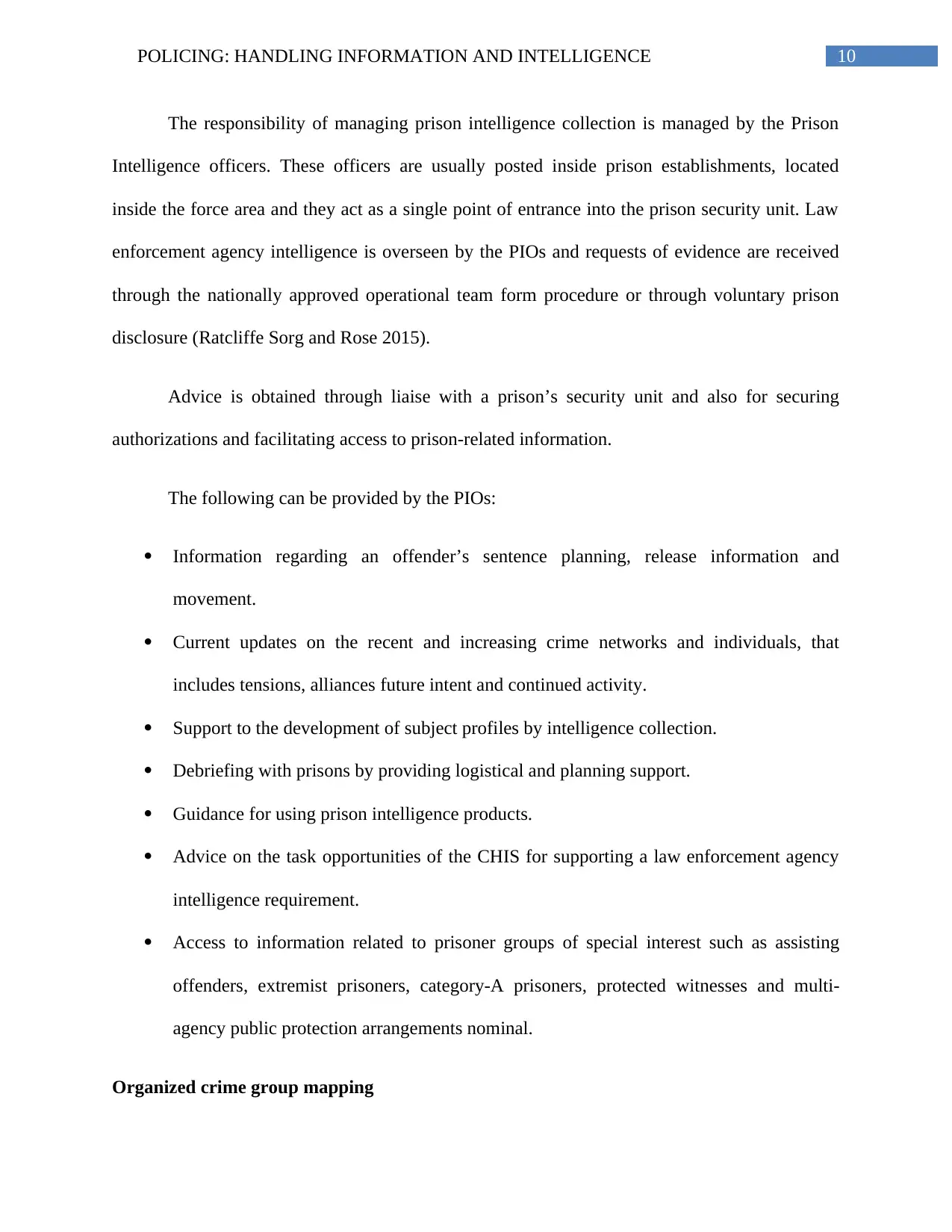
10POLICING: HANDLING INFORMATION AND INTELLIGENCE
The responsibility of managing prison intelligence collection is managed by the Prison
Intelligence officers. These officers are usually posted inside prison establishments, located
inside the force area and they act as a single point of entrance into the prison security unit. Law
enforcement agency intelligence is overseen by the PIOs and requests of evidence are received
through the nationally approved operational team form procedure or through voluntary prison
disclosure (Ratcliffe Sorg and Rose 2015).
Advice is obtained through liaise with a prison’s security unit and also for securing
authorizations and facilitating access to prison-related information.
The following can be provided by the PIOs:
Information regarding an offender’s sentence planning, release information and
movement.
Current updates on the recent and increasing crime networks and individuals, that
includes tensions, alliances future intent and continued activity.
Support to the development of subject profiles by intelligence collection.
Debriefing with prisons by providing logistical and planning support.
Guidance for using prison intelligence products.
Advice on the task opportunities of the CHIS for supporting a law enforcement agency
intelligence requirement.
Access to information related to prisoner groups of special interest such as assisting
offenders, extremist prisoners, category-A prisoners, protected witnesses and multi-
agency public protection arrangements nominal.
Organized crime group mapping
The responsibility of managing prison intelligence collection is managed by the Prison
Intelligence officers. These officers are usually posted inside prison establishments, located
inside the force area and they act as a single point of entrance into the prison security unit. Law
enforcement agency intelligence is overseen by the PIOs and requests of evidence are received
through the nationally approved operational team form procedure or through voluntary prison
disclosure (Ratcliffe Sorg and Rose 2015).
Advice is obtained through liaise with a prison’s security unit and also for securing
authorizations and facilitating access to prison-related information.
The following can be provided by the PIOs:
Information regarding an offender’s sentence planning, release information and
movement.
Current updates on the recent and increasing crime networks and individuals, that
includes tensions, alliances future intent and continued activity.
Support to the development of subject profiles by intelligence collection.
Debriefing with prisons by providing logistical and planning support.
Guidance for using prison intelligence products.
Advice on the task opportunities of the CHIS for supporting a law enforcement agency
intelligence requirement.
Access to information related to prisoner groups of special interest such as assisting
offenders, extremist prisoners, category-A prisoners, protected witnesses and multi-
agency public protection arrangements nominal.
Organized crime group mapping
Secure Best Marks with AI Grader
Need help grading? Try our AI Grader for instant feedback on your assignments.
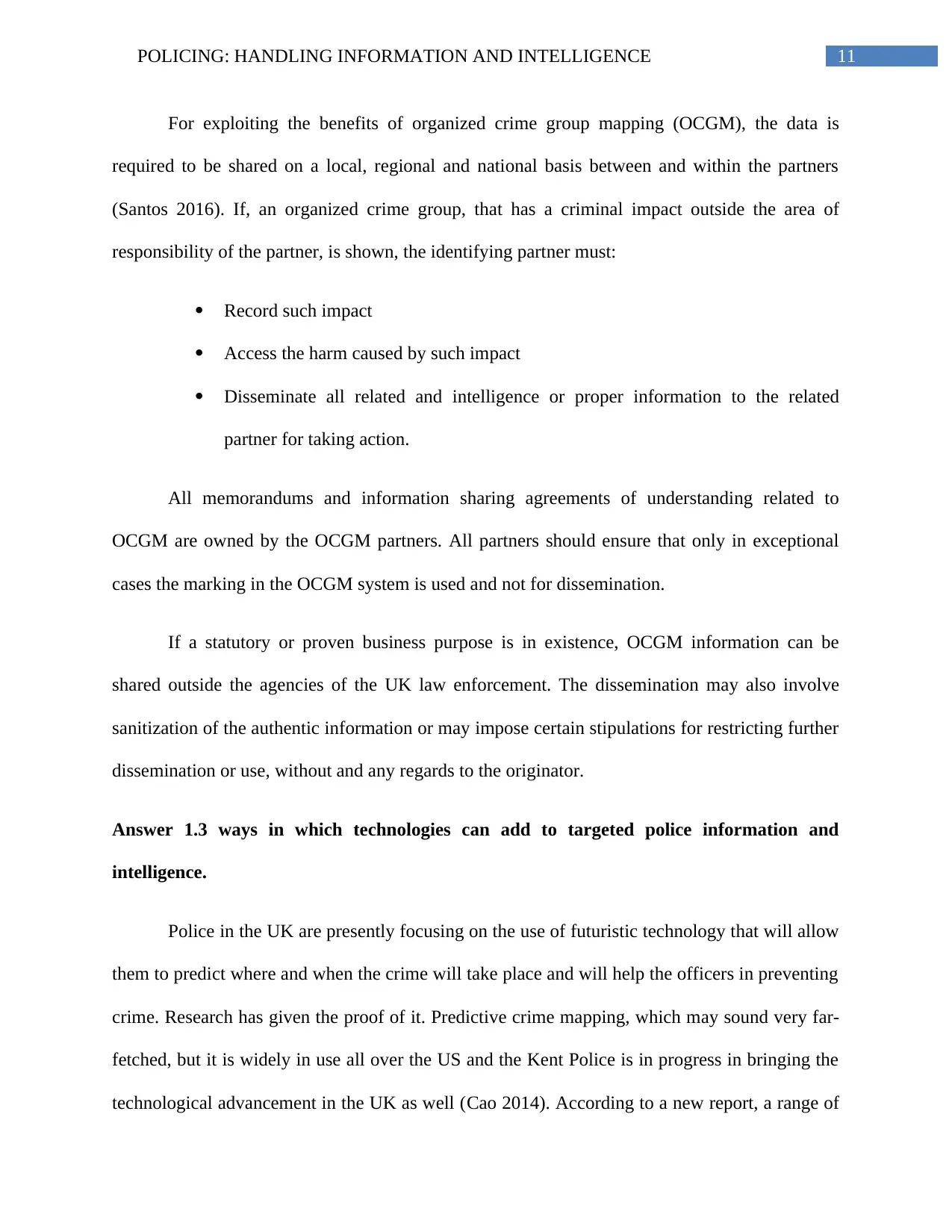
11POLICING: HANDLING INFORMATION AND INTELLIGENCE
For exploiting the benefits of organized crime group mapping (OCGM), the data is
required to be shared on a local, regional and national basis between and within the partners
(Santos 2016). If, an organized crime group, that has a criminal impact outside the area of
responsibility of the partner, is shown, the identifying partner must:
Record such impact
Access the harm caused by such impact
Disseminate all related and intelligence or proper information to the related
partner for taking action.
All memorandums and information sharing agreements of understanding related to
OCGM are owned by the OCGM partners. All partners should ensure that only in exceptional
cases the marking in the OCGM system is used and not for dissemination.
If a statutory or proven business purpose is in existence, OCGM information can be
shared outside the agencies of the UK law enforcement. The dissemination may also involve
sanitization of the authentic information or may impose certain stipulations for restricting further
dissemination or use, without and any regards to the originator.
Answer 1.3 ways in which technologies can add to targeted police information and
intelligence.
Police in the UK are presently focusing on the use of futuristic technology that will allow
them to predict where and when the crime will take place and will help the officers in preventing
crime. Research has given the proof of it. Predictive crime mapping, which may sound very far-
fetched, but it is widely in use all over the US and the Kent Police is in progress in bringing the
technological advancement in the UK as well (Cao 2014). According to a new report, a range of
For exploiting the benefits of organized crime group mapping (OCGM), the data is
required to be shared on a local, regional and national basis between and within the partners
(Santos 2016). If, an organized crime group, that has a criminal impact outside the area of
responsibility of the partner, is shown, the identifying partner must:
Record such impact
Access the harm caused by such impact
Disseminate all related and intelligence or proper information to the related
partner for taking action.
All memorandums and information sharing agreements of understanding related to
OCGM are owned by the OCGM partners. All partners should ensure that only in exceptional
cases the marking in the OCGM system is used and not for dissemination.
If a statutory or proven business purpose is in existence, OCGM information can be
shared outside the agencies of the UK law enforcement. The dissemination may also involve
sanitization of the authentic information or may impose certain stipulations for restricting further
dissemination or use, without and any regards to the originator.
Answer 1.3 ways in which technologies can add to targeted police information and
intelligence.
Police in the UK are presently focusing on the use of futuristic technology that will allow
them to predict where and when the crime will take place and will help the officers in preventing
crime. Research has given the proof of it. Predictive crime mapping, which may sound very far-
fetched, but it is widely in use all over the US and the Kent Police is in progress in bringing the
technological advancement in the UK as well (Cao 2014). According to a new report, a range of
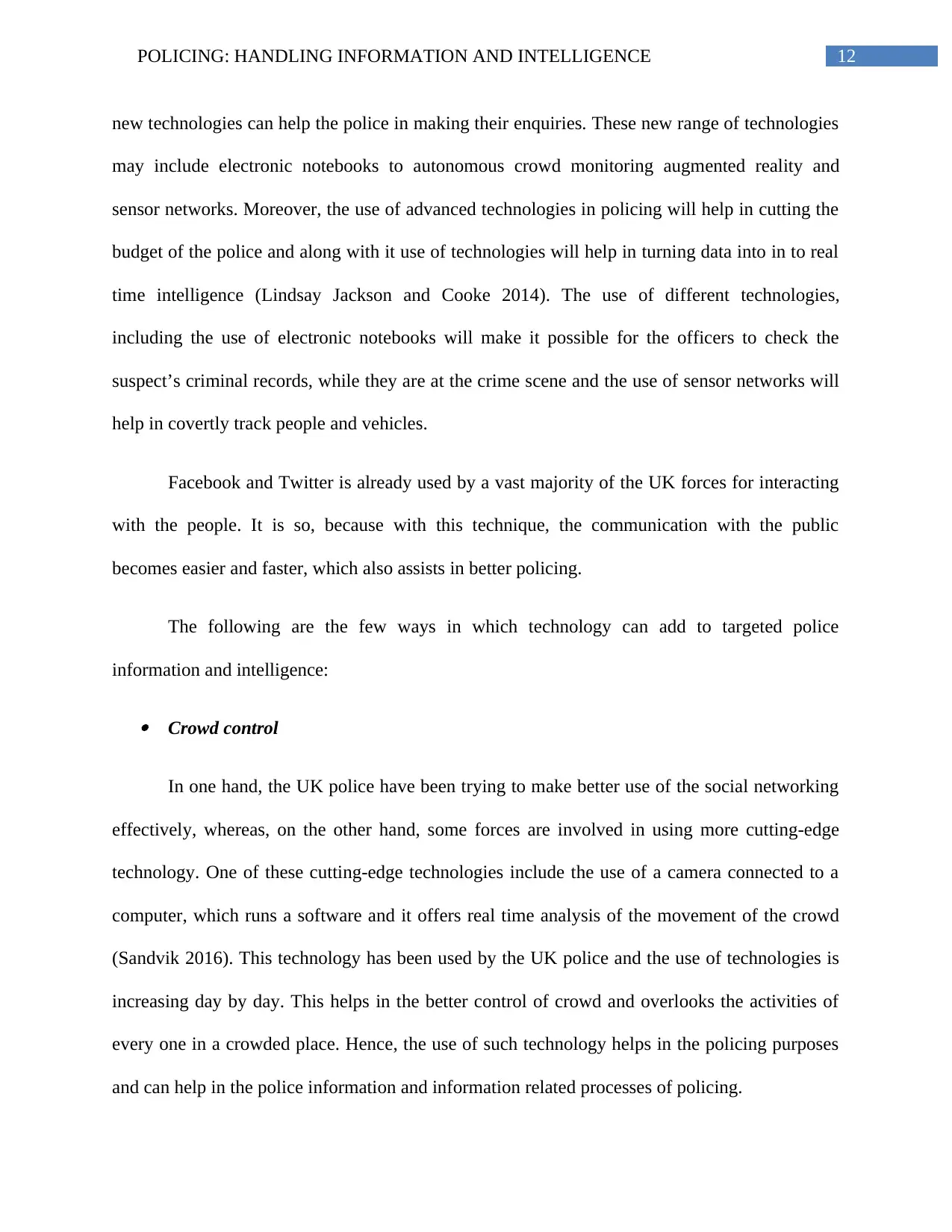
12POLICING: HANDLING INFORMATION AND INTELLIGENCE
new technologies can help the police in making their enquiries. These new range of technologies
may include electronic notebooks to autonomous crowd monitoring augmented reality and
sensor networks. Moreover, the use of advanced technologies in policing will help in cutting the
budget of the police and along with it use of technologies will help in turning data into in to real
time intelligence (Lindsay Jackson and Cooke 2014). The use of different technologies,
including the use of electronic notebooks will make it possible for the officers to check the
suspect’s criminal records, while they are at the crime scene and the use of sensor networks will
help in covertly track people and vehicles.
Facebook and Twitter is already used by a vast majority of the UK forces for interacting
with the people. It is so, because with this technique, the communication with the public
becomes easier and faster, which also assists in better policing.
The following are the few ways in which technology can add to targeted police
information and intelligence:
Crowd control
In one hand, the UK police have been trying to make better use of the social networking
effectively, whereas, on the other hand, some forces are involved in using more cutting-edge
technology. One of these cutting-edge technologies include the use of a camera connected to a
computer, which runs a software and it offers real time analysis of the movement of the crowd
(Sandvik 2016). This technology has been used by the UK police and the use of technologies is
increasing day by day. This helps in the better control of crowd and overlooks the activities of
every one in a crowded place. Hence, the use of such technology helps in the policing purposes
and can help in the police information and information related processes of policing.
new technologies can help the police in making their enquiries. These new range of technologies
may include electronic notebooks to autonomous crowd monitoring augmented reality and
sensor networks. Moreover, the use of advanced technologies in policing will help in cutting the
budget of the police and along with it use of technologies will help in turning data into in to real
time intelligence (Lindsay Jackson and Cooke 2014). The use of different technologies,
including the use of electronic notebooks will make it possible for the officers to check the
suspect’s criminal records, while they are at the crime scene and the use of sensor networks will
help in covertly track people and vehicles.
Facebook and Twitter is already used by a vast majority of the UK forces for interacting
with the people. It is so, because with this technique, the communication with the public
becomes easier and faster, which also assists in better policing.
The following are the few ways in which technology can add to targeted police
information and intelligence:
Crowd control
In one hand, the UK police have been trying to make better use of the social networking
effectively, whereas, on the other hand, some forces are involved in using more cutting-edge
technology. One of these cutting-edge technologies include the use of a camera connected to a
computer, which runs a software and it offers real time analysis of the movement of the crowd
(Sandvik 2016). This technology has been used by the UK police and the use of technologies is
increasing day by day. This helps in the better control of crowd and overlooks the activities of
every one in a crowded place. Hence, the use of such technology helps in the policing purposes
and can help in the police information and information related processes of policing.
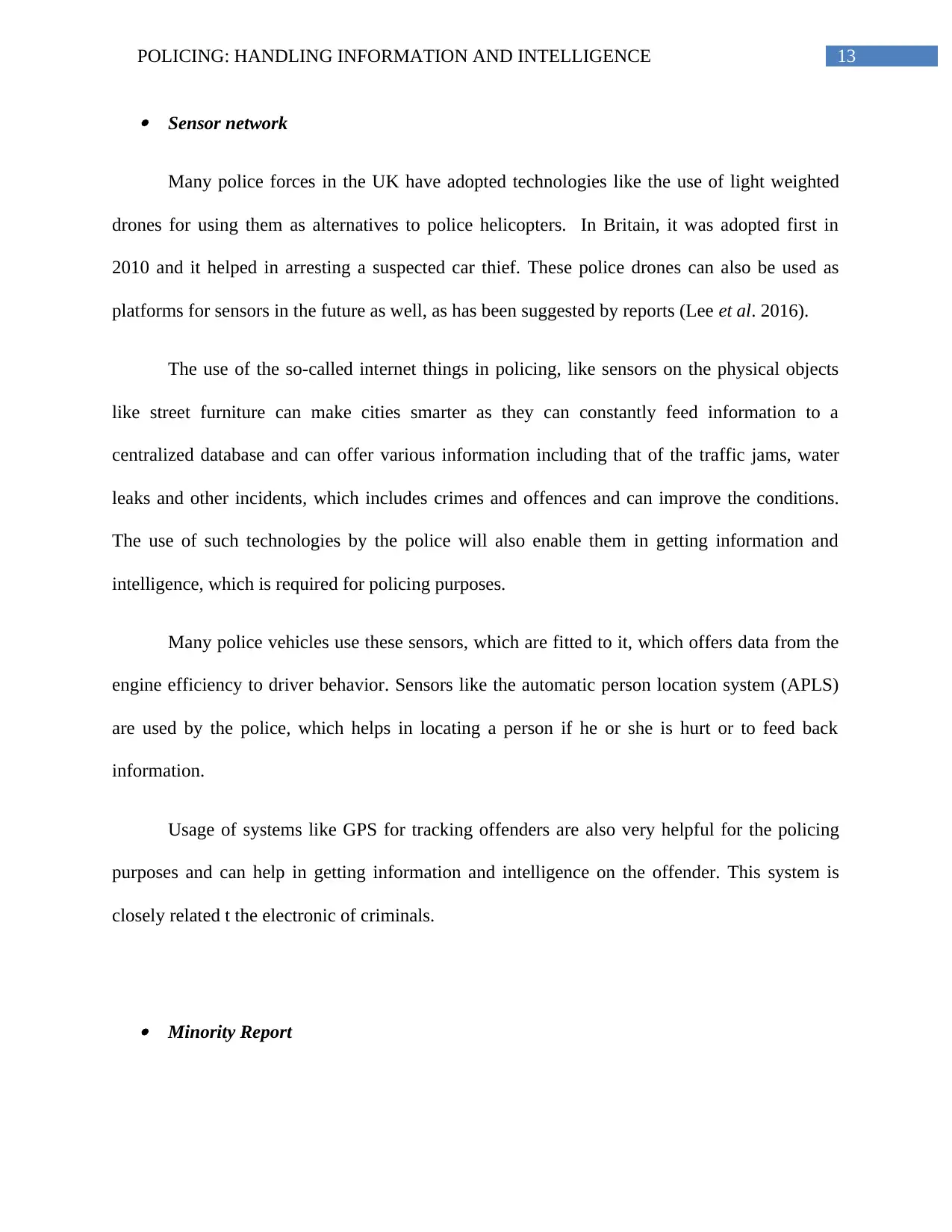
13POLICING: HANDLING INFORMATION AND INTELLIGENCE
Sensor network
Many police forces in the UK have adopted technologies like the use of light weighted
drones for using them as alternatives to police helicopters. In Britain, it was adopted first in
2010 and it helped in arresting a suspected car thief. These police drones can also be used as
platforms for sensors in the future as well, as has been suggested by reports (Lee et al. 2016).
The use of the so-called internet things in policing, like sensors on the physical objects
like street furniture can make cities smarter as they can constantly feed information to a
centralized database and can offer various information including that of the traffic jams, water
leaks and other incidents, which includes crimes and offences and can improve the conditions.
The use of such technologies by the police will also enable them in getting information and
intelligence, which is required for policing purposes.
Many police vehicles use these sensors, which are fitted to it, which offers data from the
engine efficiency to driver behavior. Sensors like the automatic person location system (APLS)
are used by the police, which helps in locating a person if he or she is hurt or to feed back
information.
Usage of systems like GPS for tracking offenders are also very helpful for the policing
purposes and can help in getting information and intelligence on the offender. This system is
closely related t the electronic of criminals.
Minority Report
Sensor network
Many police forces in the UK have adopted technologies like the use of light weighted
drones for using them as alternatives to police helicopters. In Britain, it was adopted first in
2010 and it helped in arresting a suspected car thief. These police drones can also be used as
platforms for sensors in the future as well, as has been suggested by reports (Lee et al. 2016).
The use of the so-called internet things in policing, like sensors on the physical objects
like street furniture can make cities smarter as they can constantly feed information to a
centralized database and can offer various information including that of the traffic jams, water
leaks and other incidents, which includes crimes and offences and can improve the conditions.
The use of such technologies by the police will also enable them in getting information and
intelligence, which is required for policing purposes.
Many police vehicles use these sensors, which are fitted to it, which offers data from the
engine efficiency to driver behavior. Sensors like the automatic person location system (APLS)
are used by the police, which helps in locating a person if he or she is hurt or to feed back
information.
Usage of systems like GPS for tracking offenders are also very helpful for the policing
purposes and can help in getting information and intelligence on the offender. This system is
closely related t the electronic of criminals.
Minority Report
Paraphrase This Document
Need a fresh take? Get an instant paraphrase of this document with our AI Paraphraser
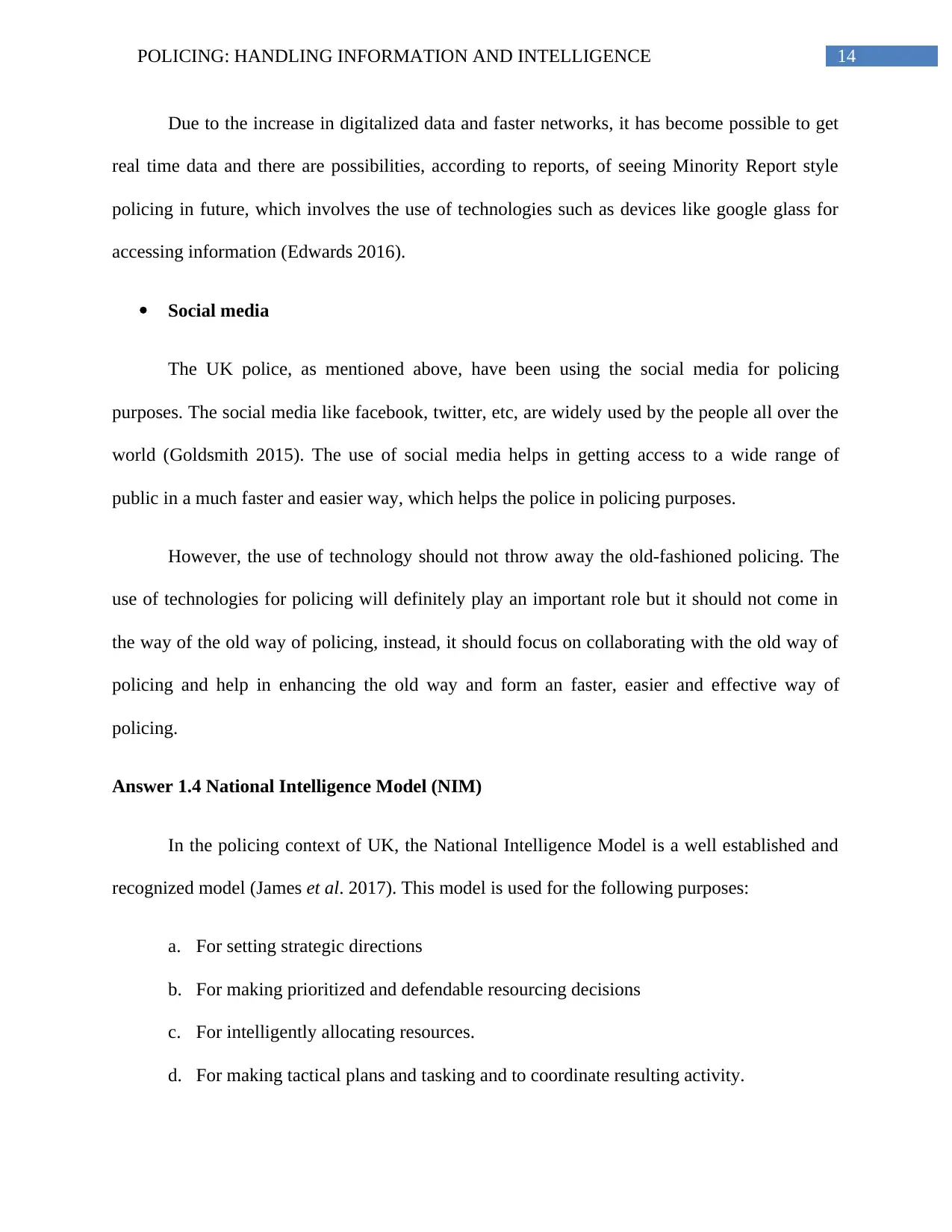
14POLICING: HANDLING INFORMATION AND INTELLIGENCE
Due to the increase in digitalized data and faster networks, it has become possible to get
real time data and there are possibilities, according to reports, of seeing Minority Report style
policing in future, which involves the use of technologies such as devices like google glass for
accessing information (Edwards 2016).
Social media
The UK police, as mentioned above, have been using the social media for policing
purposes. The social media like facebook, twitter, etc, are widely used by the people all over the
world (Goldsmith 2015). The use of social media helps in getting access to a wide range of
public in a much faster and easier way, which helps the police in policing purposes.
However, the use of technology should not throw away the old-fashioned policing. The
use of technologies for policing will definitely play an important role but it should not come in
the way of the old way of policing, instead, it should focus on collaborating with the old way of
policing and help in enhancing the old way and form an faster, easier and effective way of
policing.
Answer 1.4 National Intelligence Model (NIM)
In the policing context of UK, the National Intelligence Model is a well established and
recognized model (James et al. 2017). This model is used for the following purposes:
a. For setting strategic directions
b. For making prioritized and defendable resourcing decisions
c. For intelligently allocating resources.
d. For making tactical plans and tasking and to coordinate resulting activity.
Due to the increase in digitalized data and faster networks, it has become possible to get
real time data and there are possibilities, according to reports, of seeing Minority Report style
policing in future, which involves the use of technologies such as devices like google glass for
accessing information (Edwards 2016).
Social media
The UK police, as mentioned above, have been using the social media for policing
purposes. The social media like facebook, twitter, etc, are widely used by the people all over the
world (Goldsmith 2015). The use of social media helps in getting access to a wide range of
public in a much faster and easier way, which helps the police in policing purposes.
However, the use of technology should not throw away the old-fashioned policing. The
use of technologies for policing will definitely play an important role but it should not come in
the way of the old way of policing, instead, it should focus on collaborating with the old way of
policing and help in enhancing the old way and form an faster, easier and effective way of
policing.
Answer 1.4 National Intelligence Model (NIM)
In the policing context of UK, the National Intelligence Model is a well established and
recognized model (James et al. 2017). This model is used for the following purposes:
a. For setting strategic directions
b. For making prioritized and defendable resourcing decisions
c. For intelligently allocating resources.
d. For making tactical plans and tasking and to coordinate resulting activity.
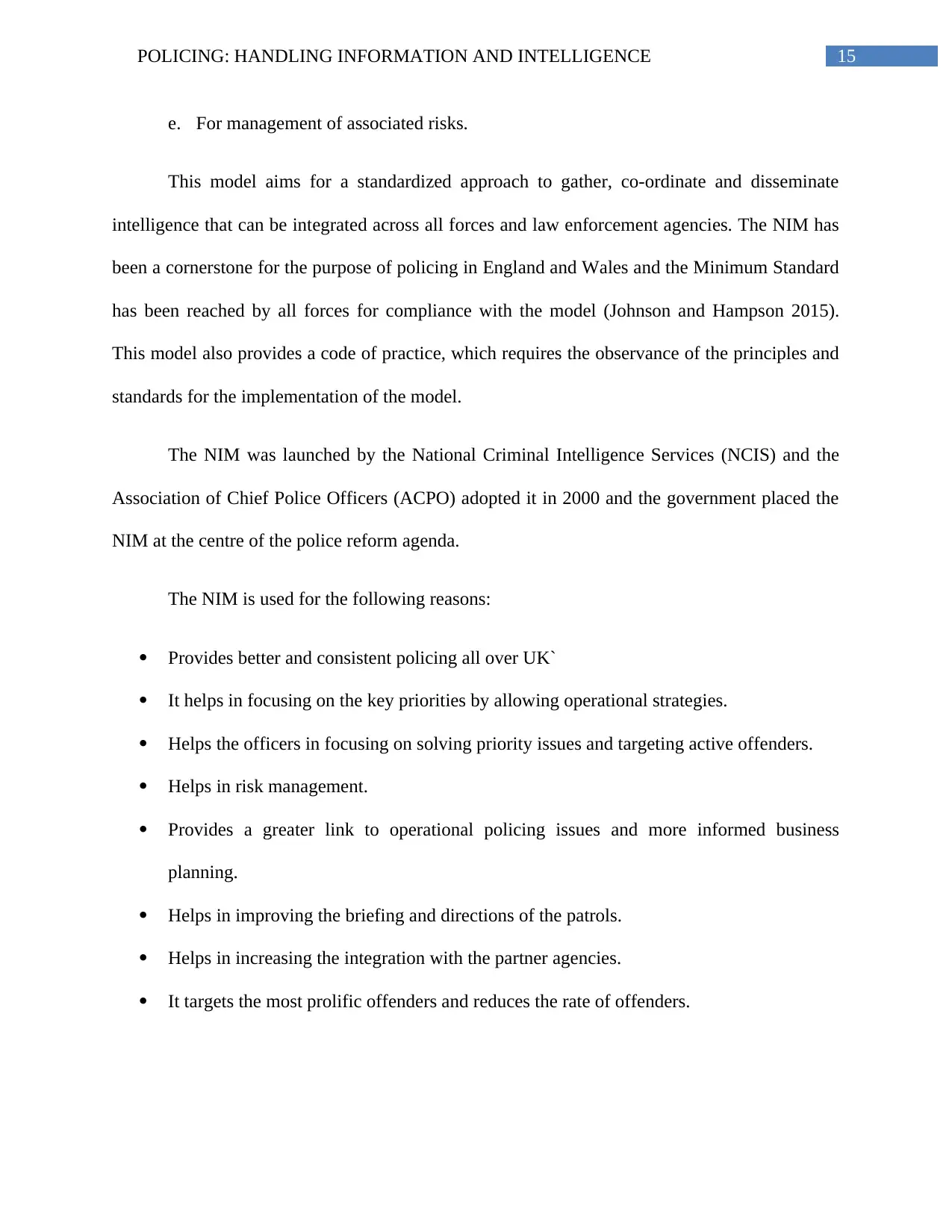
15POLICING: HANDLING INFORMATION AND INTELLIGENCE
e. For management of associated risks.
This model aims for a standardized approach to gather, co-ordinate and disseminate
intelligence that can be integrated across all forces and law enforcement agencies. The NIM has
been a cornerstone for the purpose of policing in England and Wales and the Minimum Standard
has been reached by all forces for compliance with the model (Johnson and Hampson 2015).
This model also provides a code of practice, which requires the observance of the principles and
standards for the implementation of the model.
The NIM was launched by the National Criminal Intelligence Services (NCIS) and the
Association of Chief Police Officers (ACPO) adopted it in 2000 and the government placed the
NIM at the centre of the police reform agenda.
The NIM is used for the following reasons:
Provides better and consistent policing all over UK`
It helps in focusing on the key priorities by allowing operational strategies.
Helps the officers in focusing on solving priority issues and targeting active offenders.
Helps in risk management.
Provides a greater link to operational policing issues and more informed business
planning.
Helps in improving the briefing and directions of the patrols.
Helps in increasing the integration with the partner agencies.
It targets the most prolific offenders and reduces the rate of offenders.
e. For management of associated risks.
This model aims for a standardized approach to gather, co-ordinate and disseminate
intelligence that can be integrated across all forces and law enforcement agencies. The NIM has
been a cornerstone for the purpose of policing in England and Wales and the Minimum Standard
has been reached by all forces for compliance with the model (Johnson and Hampson 2015).
This model also provides a code of practice, which requires the observance of the principles and
standards for the implementation of the model.
The NIM was launched by the National Criminal Intelligence Services (NCIS) and the
Association of Chief Police Officers (ACPO) adopted it in 2000 and the government placed the
NIM at the centre of the police reform agenda.
The NIM is used for the following reasons:
Provides better and consistent policing all over UK`
It helps in focusing on the key priorities by allowing operational strategies.
Helps the officers in focusing on solving priority issues and targeting active offenders.
Helps in risk management.
Provides a greater link to operational policing issues and more informed business
planning.
Helps in improving the briefing and directions of the patrols.
Helps in increasing the integration with the partner agencies.
It targets the most prolific offenders and reduces the rate of offenders.
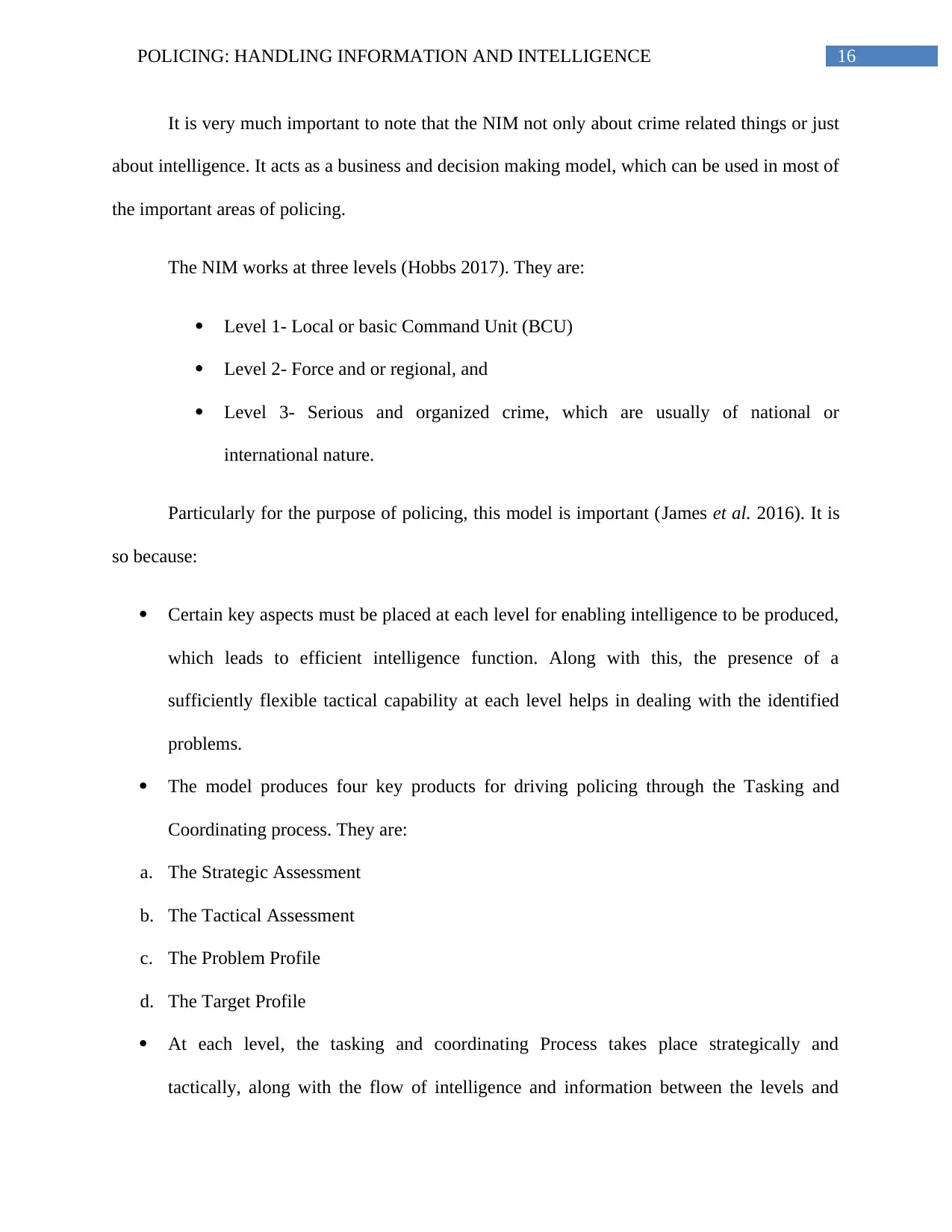
16POLICING: HANDLING INFORMATION AND INTELLIGENCE
It is very much important to note that the NIM not only about crime related things or just
about intelligence. It acts as a business and decision making model, which can be used in most of
the important areas of policing.
The NIM works at three levels (Hobbs 2017). They are:
Level 1- Local or basic Command Unit (BCU)
Level 2- Force and or regional, and
Level 3- Serious and organized crime, which are usually of national or
international nature.
Particularly for the purpose of policing, this model is important (James et al. 2016). It is
so because:
Certain key aspects must be placed at each level for enabling intelligence to be produced,
which leads to efficient intelligence function. Along with this, the presence of a
sufficiently flexible tactical capability at each level helps in dealing with the identified
problems.
The model produces four key products for driving policing through the Tasking and
Coordinating process. They are:
a. The Strategic Assessment
b. The Tactical Assessment
c. The Problem Profile
d. The Target Profile
At each level, the tasking and coordinating Process takes place strategically and
tactically, along with the flow of intelligence and information between the levels and
It is very much important to note that the NIM not only about crime related things or just
about intelligence. It acts as a business and decision making model, which can be used in most of
the important areas of policing.
The NIM works at three levels (Hobbs 2017). They are:
Level 1- Local or basic Command Unit (BCU)
Level 2- Force and or regional, and
Level 3- Serious and organized crime, which are usually of national or
international nature.
Particularly for the purpose of policing, this model is important (James et al. 2016). It is
so because:
Certain key aspects must be placed at each level for enabling intelligence to be produced,
which leads to efficient intelligence function. Along with this, the presence of a
sufficiently flexible tactical capability at each level helps in dealing with the identified
problems.
The model produces four key products for driving policing through the Tasking and
Coordinating process. They are:
a. The Strategic Assessment
b. The Tactical Assessment
c. The Problem Profile
d. The Target Profile
At each level, the tasking and coordinating Process takes place strategically and
tactically, along with the flow of intelligence and information between the levels and
Secure Best Marks with AI Grader
Need help grading? Try our AI Grader for instant feedback on your assignments.

17POLICING: HANDLING INFORMATION AND INTELLIGENCE
between the law enforcement agencies and neighboring police forces (Young 2016). The
NIM, at a straight level, has a powerful link with the features of business planning, both
in relation to the Strategies of Crime disorder Reduction Partnerships and Policing Plans.
The Government has ensured the NIM had been filly embedded in the forces’
mainstream policing and issued certain standards and principles, which are to be observed for
continuous development.
between the law enforcement agencies and neighboring police forces (Young 2016). The
NIM, at a straight level, has a powerful link with the features of business planning, both
in relation to the Strategies of Crime disorder Reduction Partnerships and Policing Plans.
The Government has ensured the NIM had been filly embedded in the forces’
mainstream policing and issued certain standards and principles, which are to be observed for
continuous development.
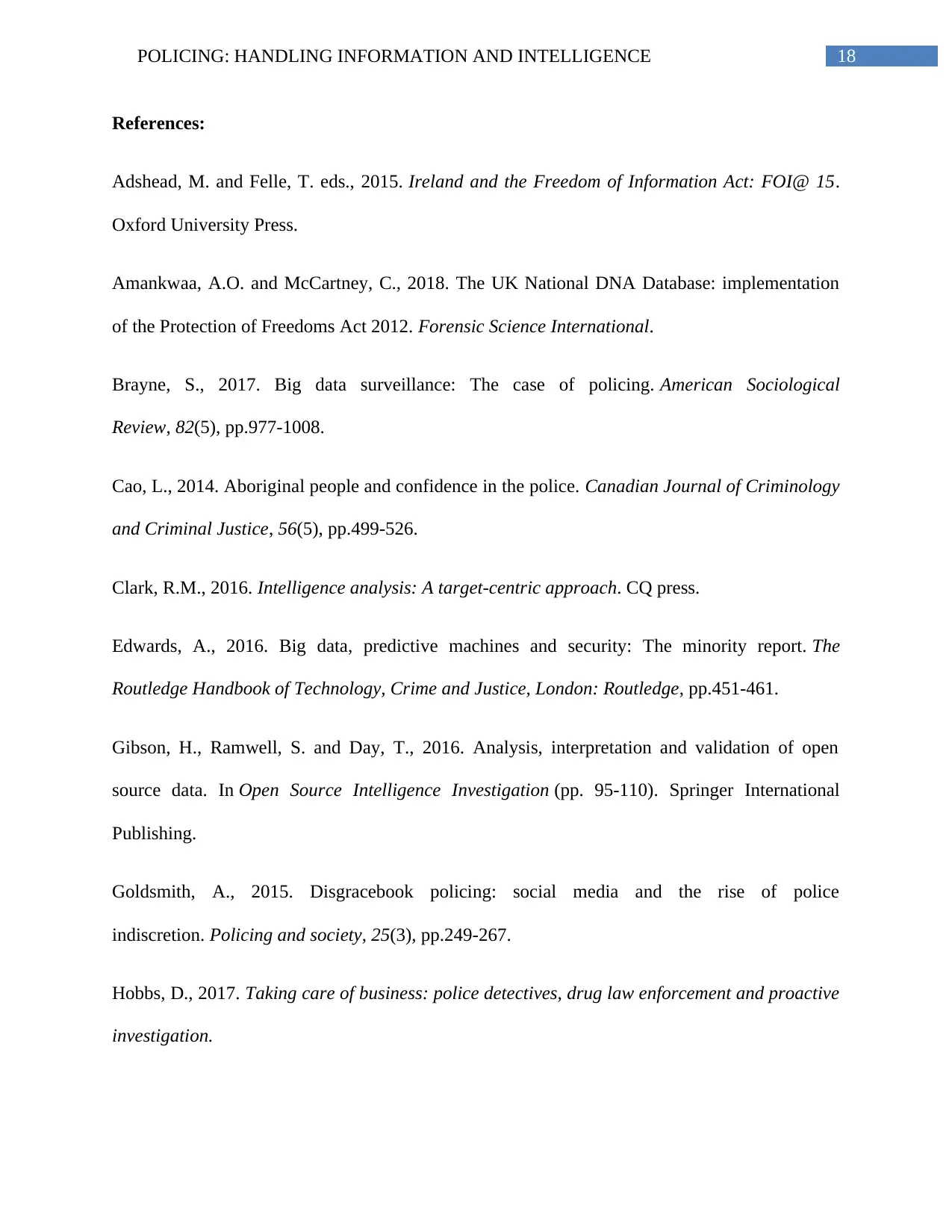
18POLICING: HANDLING INFORMATION AND INTELLIGENCE
References:
Adshead, M. and Felle, T. eds., 2015. Ireland and the Freedom of Information Act: FOI@ 15.
Oxford University Press.
Amankwaa, A.O. and McCartney, C., 2018. The UK National DNA Database: implementation
of the Protection of Freedoms Act 2012. Forensic Science International.
Brayne, S., 2017. Big data surveillance: The case of policing. American Sociological
Review, 82(5), pp.977-1008.
Cao, L., 2014. Aboriginal people and confidence in the police. Canadian Journal of Criminology
and Criminal Justice, 56(5), pp.499-526.
Clark, R.M., 2016. Intelligence analysis: A target-centric approach. CQ press.
Edwards, A., 2016. Big data, predictive machines and security: The minority report. The
Routledge Handbook of Technology, Crime and Justice, London: Routledge, pp.451-461.
Gibson, H., Ramwell, S. and Day, T., 2016. Analysis, interpretation and validation of open
source data. In Open Source Intelligence Investigation (pp. 95-110). Springer International
Publishing.
Goldsmith, A., 2015. Disgracebook policing: social media and the rise of police
indiscretion. Policing and society, 25(3), pp.249-267.
Hobbs, D., 2017. Taking care of business: police detectives, drug law enforcement and proactive
investigation.
References:
Adshead, M. and Felle, T. eds., 2015. Ireland and the Freedom of Information Act: FOI@ 15.
Oxford University Press.
Amankwaa, A.O. and McCartney, C., 2018. The UK National DNA Database: implementation
of the Protection of Freedoms Act 2012. Forensic Science International.
Brayne, S., 2017. Big data surveillance: The case of policing. American Sociological
Review, 82(5), pp.977-1008.
Cao, L., 2014. Aboriginal people and confidence in the police. Canadian Journal of Criminology
and Criminal Justice, 56(5), pp.499-526.
Clark, R.M., 2016. Intelligence analysis: A target-centric approach. CQ press.
Edwards, A., 2016. Big data, predictive machines and security: The minority report. The
Routledge Handbook of Technology, Crime and Justice, London: Routledge, pp.451-461.
Gibson, H., Ramwell, S. and Day, T., 2016. Analysis, interpretation and validation of open
source data. In Open Source Intelligence Investigation (pp. 95-110). Springer International
Publishing.
Goldsmith, A., 2015. Disgracebook policing: social media and the rise of police
indiscretion. Policing and society, 25(3), pp.249-267.
Hobbs, D., 2017. Taking care of business: police detectives, drug law enforcement and proactive
investigation.
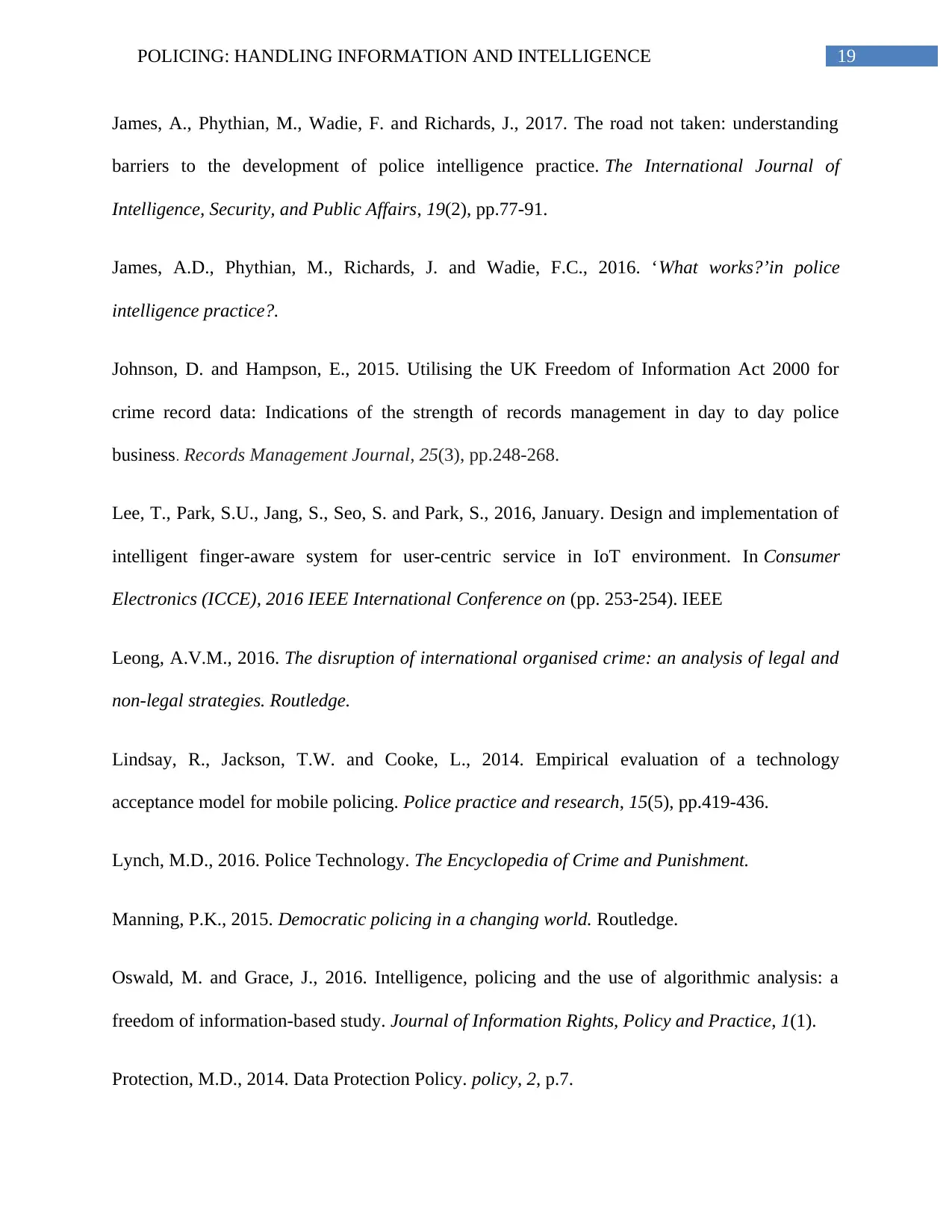
19POLICING: HANDLING INFORMATION AND INTELLIGENCE
James, A., Phythian, M., Wadie, F. and Richards, J., 2017. The road not taken: understanding
barriers to the development of police intelligence practice. The International Journal of
Intelligence, Security, and Public Affairs, 19(2), pp.77-91.
James, A.D., Phythian, M., Richards, J. and Wadie, F.C., 2016. ‘What works?’in police
intelligence practice?.
Johnson, D. and Hampson, E., 2015. Utilising the UK Freedom of Information Act 2000 for
crime record data: Indications of the strength of records management in day to day police
business. Records Management Journal, 25(3), pp.248-268.
Lee, T., Park, S.U., Jang, S., Seo, S. and Park, S., 2016, January. Design and implementation of
intelligent finger-aware system for user-centric service in IoT environment. In Consumer
Electronics (ICCE), 2016 IEEE International Conference on (pp. 253-254). IEEE
Leong, A.V.M., 2016. The disruption of international organised crime: an analysis of legal and
non-legal strategies. Routledge.
Lindsay, R., Jackson, T.W. and Cooke, L., 2014. Empirical evaluation of a technology
acceptance model for mobile policing. Police practice and research, 15(5), pp.419-436.
Lynch, M.D., 2016. Police Technology. The Encyclopedia of Crime and Punishment.
Manning, P.K., 2015. Democratic policing in a changing world. Routledge.
Oswald, M. and Grace, J., 2016. Intelligence, policing and the use of algorithmic analysis: a
freedom of information-based study. Journal of Information Rights, Policy and Practice, 1(1).
Protection, M.D., 2014. Data Protection Policy. policy, 2, p.7.
James, A., Phythian, M., Wadie, F. and Richards, J., 2017. The road not taken: understanding
barriers to the development of police intelligence practice. The International Journal of
Intelligence, Security, and Public Affairs, 19(2), pp.77-91.
James, A.D., Phythian, M., Richards, J. and Wadie, F.C., 2016. ‘What works?’in police
intelligence practice?.
Johnson, D. and Hampson, E., 2015. Utilising the UK Freedom of Information Act 2000 for
crime record data: Indications of the strength of records management in day to day police
business. Records Management Journal, 25(3), pp.248-268.
Lee, T., Park, S.U., Jang, S., Seo, S. and Park, S., 2016, January. Design and implementation of
intelligent finger-aware system for user-centric service in IoT environment. In Consumer
Electronics (ICCE), 2016 IEEE International Conference on (pp. 253-254). IEEE
Leong, A.V.M., 2016. The disruption of international organised crime: an analysis of legal and
non-legal strategies. Routledge.
Lindsay, R., Jackson, T.W. and Cooke, L., 2014. Empirical evaluation of a technology
acceptance model for mobile policing. Police practice and research, 15(5), pp.419-436.
Lynch, M.D., 2016. Police Technology. The Encyclopedia of Crime and Punishment.
Manning, P.K., 2015. Democratic policing in a changing world. Routledge.
Oswald, M. and Grace, J., 2016. Intelligence, policing and the use of algorithmic analysis: a
freedom of information-based study. Journal of Information Rights, Policy and Practice, 1(1).
Protection, M.D., 2014. Data Protection Policy. policy, 2, p.7.
Paraphrase This Document
Need a fresh take? Get an instant paraphrase of this document with our AI Paraphraser
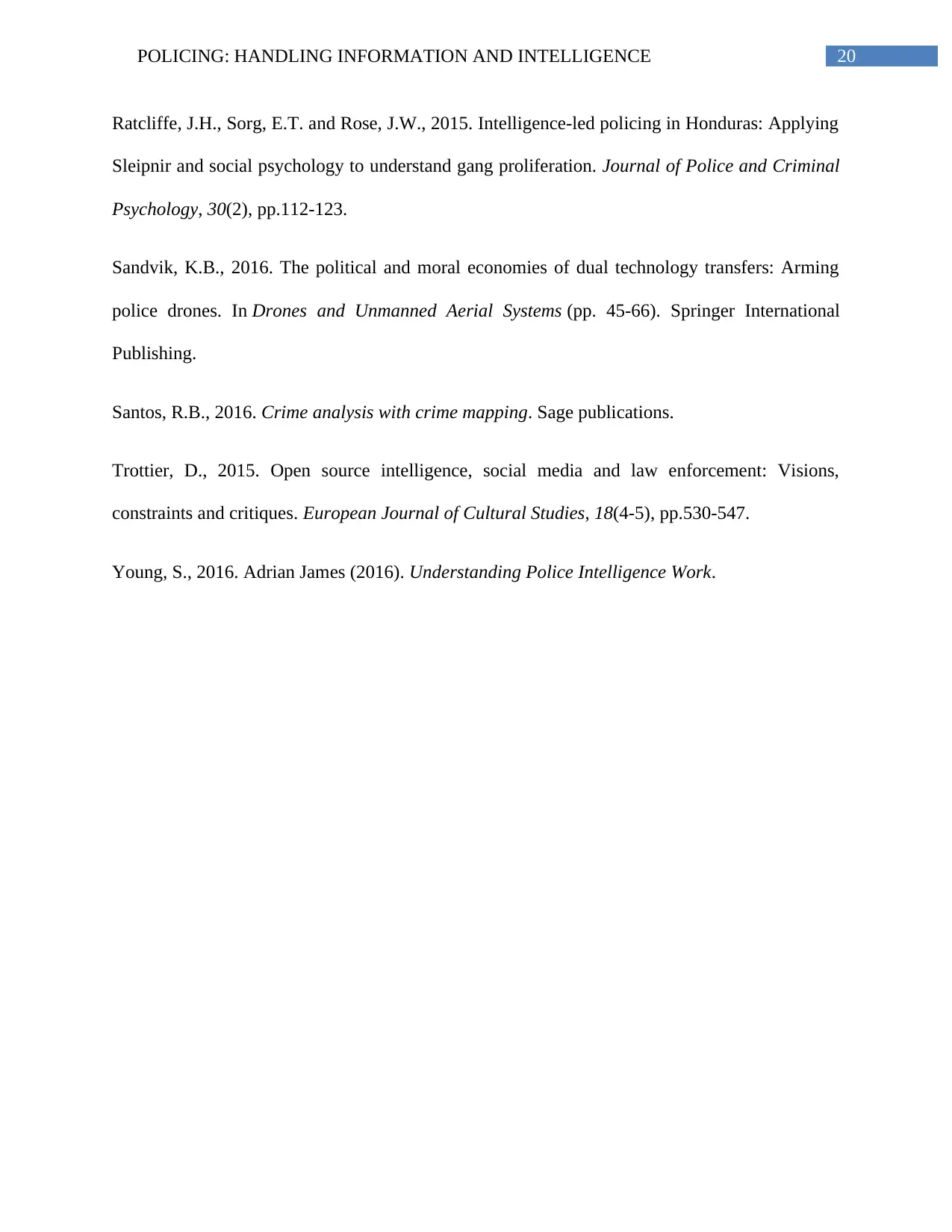
20POLICING: HANDLING INFORMATION AND INTELLIGENCE
Ratcliffe, J.H., Sorg, E.T. and Rose, J.W., 2015. Intelligence-led policing in Honduras: Applying
Sleipnir and social psychology to understand gang proliferation. Journal of Police and Criminal
Psychology, 30(2), pp.112-123.
Sandvik, K.B., 2016. The political and moral economies of dual technology transfers: Arming
police drones. In Drones and Unmanned Aerial Systems (pp. 45-66). Springer International
Publishing.
Santos, R.B., 2016. Crime analysis with crime mapping. Sage publications.
Trottier, D., 2015. Open source intelligence, social media and law enforcement: Visions,
constraints and critiques. European Journal of Cultural Studies, 18(4-5), pp.530-547.
Young, S., 2016. Adrian James (2016). Understanding Police Intelligence Work.
Ratcliffe, J.H., Sorg, E.T. and Rose, J.W., 2015. Intelligence-led policing in Honduras: Applying
Sleipnir and social psychology to understand gang proliferation. Journal of Police and Criminal
Psychology, 30(2), pp.112-123.
Sandvik, K.B., 2016. The political and moral economies of dual technology transfers: Arming
police drones. In Drones and Unmanned Aerial Systems (pp. 45-66). Springer International
Publishing.
Santos, R.B., 2016. Crime analysis with crime mapping. Sage publications.
Trottier, D., 2015. Open source intelligence, social media and law enforcement: Visions,
constraints and critiques. European Journal of Cultural Studies, 18(4-5), pp.530-547.
Young, S., 2016. Adrian James (2016). Understanding Police Intelligence Work.
1 out of 20
Related Documents
Your All-in-One AI-Powered Toolkit for Academic Success.
+13062052269
info@desklib.com
Available 24*7 on WhatsApp / Email
![[object Object]](/_next/static/media/star-bottom.7253800d.svg)
Unlock your academic potential
© 2024 | Zucol Services PVT LTD | All rights reserved.





